 |
PROPOSED RULES
Original Notice.
Preproposal statement of inquiry was filed as WSR [06-09-051 on] April 14, 2006.
Title of Rule and Other Identifying Information: Chapter 173-201A WAC, Water quality standards for surface waters of the state of Washington. This rule making would be directed toward correcting deficiencies noted by EPA in their formal disapproval (March 22, 2006) of Washington's 2003 revisions to the state surface water quality standards (chapter 173-201A WAC).
Hearing Location(s): Olympia, Department of Ecology Auditorium, 300 Desmond Drive, Lacey, WA 98504, on August 7, 2006, workshop starts at 6:00 p.m., hearing immediately following; Longview, Lower Columbia College, Student Building, 1600 Maple Street, Longview, WA 98632, on August 8, 2006, workshop starts at 6:00 p.m., hearing immediately following; Bellingham, Whatcom County Courthouse, 311 Grand Avenue, Bellingham, WA 98225, on August 9, 2006, workshops start at 6:00 p.m., hearing immediately following; Wenatchee, Douglas County PUD, 1151 Valley Mall Parkway, East Wenatchee, WA 98802-4497, on August 14, 2006, workshops start at 6:00 p.m., hearing immediately following; and in the Tri-Cities, Benton County PUD, 2727 West Tenth Avenue, Kennewick, WA 99336, on August 15, 2006, workshops start at 6:00 p.m., hearing immediately following.
Date of Intended Adoption: October 31, 2006.
Submit Written Comments to: Sabrina Payne, Water Quality Program, Department of Ecology, P.O. Box 47600, Olympia, WA 98504-7600, e-mail SPAY461@ecy.wa.gov, fax (360) 407-6426, received by September 5, 2006.
Assistance for Persons with Disabilities: Contact Sabrina Payne by August 1, 2006, TTY (800) 833-6388, or (360) 407-6157.
Purpose of the Proposal and Its Anticipated Effects, Including Any Changes in Existing Rules: This proposed corrective rule would:
• Change the designated uses for many rivers from "spawning and noncore rearing" to "core summer salmonid habitat" and change rule text to support the basis for these changes. This change will result in many rivers going from a seven-day average temperature of 17.5°C to a seven-day average daily maximum of 16°C and the dissolved oxygen criteria will go from 8.0 mg/l to 9.5 mg/l.
• Change a small number of rivers to the "char spawning and rearing" designated use type and change rule text to support the basis for these changes. This change will result in some rivers going to a seven-day average daily maximum of 12°C from the old daily seven-day average of 16°C or 17.5°C.
• Add spawning locations and timing windows where explicit spawning/incubation temperature criteria would apply for salmonids. These changes will apply a seven-day average daily maximum criterion of 13°C to protect spawning and incubation of salmon and trout (9ºC for the spawning of bull trout).
• Correct miscellaneous minor (typographic) errors introduced during the 2003 rule making.
Statutory Authority for Adoption: RCW 90.48.035.
Statute Being Implemented: Chapter 90.48 RCW.
Rule is necessary because of federal law, 40 FRI 131.20.
Name of Proponent: Department of ecology.
Name of Agency Personnel Responsible for Drafting, Implementation and Enforcement: Melissa Gildersleeve, Department of Ecology Headquarters, (360) 407-6461.
A small business economic impact statement has been prepared under chapter 19.85 RCW.
1. Regulatory Background: The Clean Water Act (CWA) directs states, with oversight by the Environmental Protection Agency (EPA), to adopt water quality standards (WQS) to protect the public health and welfare, enhance the quality of water, and serve the purposes of the CWA. Under section 303, states are required to hold public hearings once every three years for the purpose of reviewing applicable WQS and, as appropriate, modifying and adopting standards. The results of this triennial review must be submitted to EPA, and EPA must approve or disapprove any new or revised standards. Section 303(c) also directs the EPA administrator to promulgate WQS to supersede state standards that have been disapproved or in cases where the administrator determines that a new or revised standard is needed to meet CWA requirements.
On July 28, 2003, the state of Washington submitted revisions to its WQS to EPA for review pursuant to CWA section 303 (c)(2)(A). Certain of these revisions identified specific numeric temperature and dissolved oxygen (DO) criteria to protect critical life stages of salmonids, including criteria for salmonid rearing and spawning. On January 12, 2004, EPA approved some of the revised standards submitted by Washington, including provisions on recreational uses and bacteria criteria, freshwater water supply uses, nutrient criteria for lakes, radioactive substances, toxics and aesthetics, variance procedures, site-specific criteria, and use attainability analysis. However, EPA did not take action on a number of other provisions, including specific aquatic life use designations and their associated temperature criteria, because it needed additional time to complete an internal evaluation.
After reviewing the available fish distribution data, EPA Region 10 disapproved:
• The narrative spawning criteria of 13°C and 9°C for protection of salmonid and char spawning, respectively, because ecology did not specify when or where the criteria are needed and certain waters that ecology designated for:
| o | Noncore rearing with a 17.5°C temperature criterion because they should be designated for core summer salmonid habitat with a temperature criterion of 16°C. |
| o | Noncore rearing with a temperature criterion of 17.5°C or core rearing with a 16°C temperature criterion because they should be designated for char habitat with a 12°C temperature criterion. |
| o | Rearing and migration only with a 17.5°C temperature criterion because they should be designated salmonid spawning, rearing, and migration with a 17.5°C temperature criterion. |
2. Purpose of the Analysis: The Washington Administrative Procedure Act [Regulatory Fairness Act] (chapter 19.85 RCW) requires that, before adopting a rule under chapter 34.05 RCW, state agencies prepare a small business economic impact statement to determine whether the proposed rule will have a disproportionate impact on the state's small businesses because of the size of those businesses. Among other requirements, the impact statement must compare the cost of compliance for small business with the cost of compliance for the 10% of businesses that are the largest businesses required to comply with the proposed rules.
In 2003, ecology adopted revisions to the state's WQS (chapter 173-201A WAC) pursuant to state statutory authority under the Water Pollution Control Act (chapter 90.48 RCW), and the CWA as described above. However, EPA determined that the proposed use designations and associated temperature criteria for certain waters do not meet the requirements of the CWA because they do not provide adequate protection of core summer salmonid habitat, salmonid spawning, rearing, and migration, and char habitat. Therefore, ecology is proposing the minimum provisions that will meet EPA's approval: Locations of state waters designated for salmonid spawning, rearing, and migration, core summer salmonid habitat, spawning, and char use that will be subject to specific temperature and DO criteria.
The purpose of this report is to provide information on the potential incremental impacts to small businesses that may be associated with proposed provisions. The analysis reflects impacts that are above and beyond those associated with the 2003 WQS revision, and is based on existing sources of temperature and DO impairment, and publicly available data and information.
3. Proposed Criteria and Designated Uses: This analysis encompasses only those waters for which the 2006 proposal includes a more stringent criterion than contained in the 2003 standards revision. Exhibit 1 provides a summary of these areas of discrepancy.
| 2003 WQS Revision | Proposed Rule | ||||
| Designated Use | Temperature Criteria1 | DO Criteria2 | Designated Use | Temperature Criteria1 | DO Criteria2 |
| Char | 12°C | 9.5 mg/L | Char | 12°C | 9.5 mg/L |
| Salmonid Spawning, Core Rearing, and Migration | 16°C | 9.5 mg/L | Core Summer Salmonid Habitat | 16°C | 9.5 mg/L |
| Salmonid Spawning, Noncore Rearing, and Migration | 17.5°C | 8.0 mg/L | Salmonid Spawning, Rearing, and Migration | 17.5°C | 8.0 mg/L |
| Rearing and Migration Only | 17.5°C | 6.5 mg/L | Rearing and Migration Only | 17.5°C | 6.5 mg/L |
| Spawning (narrative) | 13°C | NA | Spawning (location and date specified) | 13°C | NA |
1. Criteria specified as 7-DADM temperatures.
2. Criteria specified as 1-day minimum DO concentrations.
2. Spawning criteria are to be specified where ecology determines that temperature criteria established for a water body would likely not result in protection of spawning and incubation.
4. Potentially Affected Sources: The proposed rule does
not include any specific requirements for businesses.
However, the proposal establishes revised criteria for
temperature and DO for several waters in the state, and
businesses that discharge to these waters may be affected
directly or indirectly by these provisions.
Point Source Facilities: Exhibit 2 shows the individual NPDES-permitted facilities located within a 2,000-foot buffer of the affected stream segments. State geographic information system (GIS) files for NPDES permit holders do not include exact location information for the outfall of the discharge. A 2,000-foot buffer may over- or under-estimate facilities discharging to affected stream segments.
The exhibit does not include general permitted facilities. Data for these facilities are extremely limited, and flows from such facilities are usually negligible. In addition, few general permits currently contain requirements to monitor for temperature, DO, BOD, or nutrients, and none of them currently contain numeric effluent limits. Thus, there are no data available to evaluate the impact that the revised 2006 standards would have on general facilities. Note that, ecology is beginning to require additional monitoring in a number of general permits. If such monitoring shows that the discharger has the potential to cause or contribute to an exceedance of the proposed criteria, the permits could be changed to include temperature or DO limits, or a general permitted facility may be given an individual permit with requirements for temperature or DO in the context of a TMDL.
| Standard Industrial Classification | Number of Facilities | ||
| Majors | Minors | ||
| Agriculture, Forestry, and Fishing | |||
| 161 | Vegetables and Melons | - | 1 |
| 921 | Fish Hatcheries and Preserves | - | 10 |
| Construction | |||
| 1794 | Excavation Work | - | 1 |
| Manufacturing | |||
| 2411 | Logging | - | 2 |
| 2491 | Wood Preserving | - | 2 |
| Transportation and Public Utilities | |||
| 4212 | Local Trucking Without Storage | - | 1 |
| 4952 | Sewerage Services (POTWs) | 5 | 25 |
| Services | |||
| 8711 | Engineering Services | - | 1 |
| Public Administration | |||
| 9711 | National Security | - | 1 |
| 9999 | Nonclassifiable Establishments | - | 1 |
| Total | 5 | 45 | |
| Source: Based on Washington state GIS files of NPDES
facilities and affected waters. '-' = None. 1. Does not include general permits. |
Nonpoint Sources: Exhibit 3 summarizes the number of stream miles affected by the revised temperature and DO criteria, and the associated uses of adjacent land. Note, most of the waters affected by the changes in temperature criteria are also affected by the changes in DO criteria; only those waters designated for rearing and migration under the 2003 WQS revision that are now designated for salmonid spawning, rearing, and migration are affected by a change in DO criteria and not also a change in temperature criteria.
| Temperature Criteria | Dissolved Oxygen Criteria | |||||
| Land Cover | Char1 | Core Summer Salmonid2 | Spawning3 | Char4 | Core Summer Salmonid2 | Salmonid SRM5 |
| Forest Land | ||||||
| Deciduous Forest | 42 | 1,081 | 547 | 0 | 1,393 | 0.01 |
| Evergreen Forest | 894 | 2,168 | 1,357 | 3.2 | 2,791 | 0.5 |
| Mixed Forest | 27 | 1,006 | 574 | 0.1 | 1,326 | 0.01 |
| Agriculture | ||||||
| Fallow Crops | 0 | 6 | 3 | 0 | 7.2 | 0.01 |
| Row Crops | 0 | 8 | 14 | 0 | 14 | 1.7 |
| Small Grains | 0 | 80 | 35 | 0 | 129 | 0.01 |
| Pasture/Hay | 1 | 259 | 149 | 0.1 | 853 | 0.4 |
| Orchards/Vineyards/Other | 0 | 13 | 36 | 0 | 20 | 0.8 |
| Urban | ||||||
| Commercial/Industrial/ Transportation | 1 | 23 | 30 | 0.01 | 42 | 0.2 |
| High Intensity Residential | 0 | 0 | 0 | 0 | 0.1 | 0 |
| Low Intensity Residential | 0 | 58 | 69 | 0.04 | 94 | 0.8 |
| Urban/Recreational Grasses | 0 | 1 | 1 | 0 | 1.9 | 0 |
| Other Potentially Plantable Land | ||||||
| Grasslands/Herbaceous | 28 | 84 | 66 | 0.2 | 105 | 0.1 |
| Shrubland | 28 | 239 | 182 | 0.2 | 273 | 1.1 |
| Transitional | 31 | 135 | 50 | 0.8 | 150 | 0 |
| Unplantable Land | ||||||
| Bare Rock/Sand/Clay | 22 | 6 | 47 | 0.01 | 33 | 0.1 |
| Emergent Herbaceous Wetlands | 0 | 1 | 5 | 0 | 5.6 | 0 |
| Open Water | 47 | 148 | 689 | 0.2 | 958 | 3.0 |
| Quarries/Strip Mines/Gravel Pits | 0 | 0 | 1 | 0 | 0.4 | 0 |
| Woody Wetlands | 5 | 83 | 81 | 0.02 | 127 | 0 |
| Total | 1,126 | 5,383 | 3,933 | 4.9 | 8,325 | 8.6 |
Source: USGS (1999a), reflecting data from 1986 to 1996. Note that, the reliability of the land cover data is greatest at the state or multi-state level (see USGS, 1999b).
1. Waters that ecology designated for either noncore or core rearing in the 2003 WQS revision that should be designated for char habitat.
2. Waters that ecology designated for noncore rearing in the 2003 WQS revision that should be designated for core summer salmonid habitat.
3. Waters for which the salmonid spawning criterion applies at specific locations and times of the year.
4. Waters that ecology designated for noncore rearing in the 2003 revision that should be designated for char habitat.
5. Waters that ecology designated for rearing and migration only in the 2003 revision that should be designated for salmonid spawning, rearing, and migration.
The TMDLs ecology developed to meet existing temperature
standards indicate that increased effective shade is most
likely the most effective means of reducing stream
temperatures, and the primary measure suggested for nonpoint
source control is riparian buffers (ecology, 2006). Thus,
riparian buffers are also likely to be the primary nonpoint
source measure implemented for compliance with the temperature
standards of the proposed rule. In addition, riparian buffers
also provide filtration and serve other functions that reduce
nutrient loadings to water. Reduced loadings of nutrients and
sediment (including organic matter) will result in reduced
BOD, which will in turn lead to higher instream DO
concentrations. Lower stream temperatures also contribute to
higher DO levels, since oxygen is more soluble in lower
temperature water.
Forestry: Approximately 73% of the land cover adjacent to affected waters is forest land. Washington regulates forestry activities on state and private lands through the Washington Forest Practices Act (chapter 76.09 RCW) and the associated forest practices rules (TITLE 222 WAC). The Washington forest practices board (the authority empowered to enforce forest practices rules) designed and adopted the forest practice rules, in part, to meet the requirements of the CWA and state WQS. The rules contain an array of best management practices (BMPs), including forest buffer requirements, to protect water quality, provide fish and wildlife habitat, protect capital improvements, and ensure that harvested areas are reforested. Thus, no additional practices would be required as a result of the proposed standards.
Agriculture: Agricultural and other plantable land make up the next largest land cover category (about 14% of the total). Riparian buffers may be needed on all agricultural and plantable land adjacent to affected waters to achieve the proposed standards. Note, however, that existing regulations in some counties require new agricultural operations to keep or plant riparian buffers (ecology, 2003), and thus, some of these costs are attributable to baseline regulations.
Urban Development: Urban development accounts for approximately 2% of the land cover adjacent to affected waters. Business related storm water may affect water quality. Storm water management is related primarily to land use. The regulation of land use is governed by the State Environmental Policy Act (SEPA), the Shoreline Management Act (SMA), and the Growth Management Act (GMA), as well as local ordinances prohibiting development in floodplains. Current storm water practices represent the best available methods for managing urban storm water. Therefore, it is not likely that businesses will be required to implement any substantive changes to currently accepted storm water practices. However, riparian buffers may be needed to shade streams that run through urban areas to help reduce instream temperatures.
Hydromodifications: State data indicate that there are one hundred forty-six dams within five hundred feet of affected waters (ecology, 2006). Fourteen of these dams are federally owned; the remainder are state or privately owned. Dam modifications (e.g., reductions in storage capacity, relocating outlet) may be needed for those dams located upstream of affected waters to comply with the proposed standards. However, sufficient monitoring data are not available to assess the impact that each of these dams may have on downstream stream temperatures or DO concentrations. Given the lack of available data and the factors that influence which control actions should be implemented, it is not possible to estimate incremental control costs for dams associated with the proposed rule, although it is likely that controls necessary to meet the 2003 WQS revisions (i.e., baseline standards) would also result in compliance with the 2006 proposed standards (ecology, 2006).
Water Withdrawals: The potential impact of the proposed rule on existing water rights is likely to be limited (ecology, 2006). The state can purchase existing water rights from willing owners in order to enhance instream flows. In these instances, the water right owner makes the exchange voluntarily, which implies that the benefits for the owner equal or exceed the cost of giving up the water right.
5. Overview of Impact Analysis: A small business economic impact analysis is a distributional analysis. Distributional analyses provide information about the economic impacts of a selected option (who gains and who loses, and by how much), and how those impacts might differ throughout the affected area. Distributional analyses include economic impact analysis, and a variety of equity analyses; equity analyses evaluate the impacts on particular subpopulations, such as small businesses. U.S. EPA (2000) describes various methods of distributional analysis.
Washington administrative procedures (RCW 19.85.040) specify a particular comparison of business impacts -- cost of compliance for small businesses to the cost of compliance for the 10% of businesses that are the largest businesses required to comply with the proposed rules using one or more of the following as a basis for comparison: Cost per employee; cost per labor hour; cost per one hundred dollars of sales.
An economic impact analysis, such as the small business impact analysis, involves evaluation of the private or "out-of-pocket" costs of the regulation. The private or out-of-pocket costs for new pollution control measures will most likely equal the social or opportunity costs of these actions. However, not all private costs represent social costs (a real resource allocation that has an opportunity cost). For example, a transfer payment such as a tax is a private cost that is not a social cost. A tax merely transfers money from one entity to another, but does not represent an opportunity cost of real resources such as the labor and materials used to implement treatment controls. Similarly, there are social costs that do not have corresponding out-of-pocket expenses and, therefore, are not included in private cost estimates. For example, buffer costs that are offset by funding from a cost-sharing program do not represent incremental expenses to the farmer, and are not included in evaluating impacts on small farm businesses.
Thus, in addition to the incremental control costs estimated in the cost-benefit analysis for the potentially affected source sectors (ecology, 2006), any private costs (e.g., taxes) that these entities experience are relevant in an impact analysis. The rule does not subject businesses to any new taxes or fees. However, since private entities can deduct the cost of pollution control equipment from income as a cost of business, private compliance costs may be lower than the estimated social costs.1 For agricultural producers, there may also be reductions in property taxes paid on land used for buffers rather than production (ecology, 2003). To the extent that such assessed property value reductions occur, the result is a shift in tax burden to other property owners.
Another key difference between social and private costs is the effect of state and federal grant and loan programs that reduce the private or out-of-pocket costs for conservation measures such as riparian buffers or pollution control equipment. These programs typically offer financial and technical assistance in the form of grants or low-interest loans to install or implement structural or managerial practices to reduce pollution. For example, ecology provides grants and low-interest loans to certain public and private entities through the Centennial Clean Water Fund, State Water Pollution Control Revolving Loan Fund, and Section 319 Nonpoint Source Fund (ecology, 2005). Under this program, for instance, a local sewer district could use a low interest loan to pay capital costs for a treatment plant upgrade, with the effect of reducing debt repayment costs, and therefore, costs that could be passed through to local small businesses.
6. Industrial Sector Impacts: Analysis of the potential costs of the proposed rule (ecology, 2006) indicates that minor industrial facilities may require incremental controls. However, only one out of twenty minor industrial facilities with individual NPDES permits located on waters affected by the proposed rule is considered a small business (i.e., an entity that is owned and operated independently from all other businesses, and has fifty or fewer employees): Brooks Manufacturing (WA0030805). This facility is in the sample ecology evaluated in the cost-benefit analysis (ecology, 2006).
Reporting and record-keeping requirements for these facilities would not likely increase beyond what is already required for holders of individual NPDES permits. The permit for Brooks Manufacturing indicates that the facility may only discharge storm water. In addition, the permit does not mention temperature, DO, BOD, nitrogen, or phosphorus, which suggests that the facility is not likely to incur control costs. Therefore, there are not likely to be disproportionate impacts on small industrial dischargers.
It is also unlikely that the proposed rule will result in an impact on general permitted facilities. Currently, general permits do not include temperature or DO limits. However, if general permitted facilities receive individual permits with requirements for temperature or DO in the future, the potential compliance cost could be disproportionate in terms of cost per employee or cost per $100 of sales compared to compliance costs for the largest affected businesses.
7. Municipal Sector Impacts: Analysis of the potential cost of the proposed rule (ecology, 2006) indicates that municipal wastewater facilities may incur control costs associated with the proposed rule. Municipal facilities are not small businesses, however, they could pass their control costs onto consumers (e.g., households and indirect commercial and industrial dischargers) through rate increases. Although it is not possible to predict which dischargers to each facility would be affected and by how much, potential rate increases could represent a disproportionate cost per employee or cost per $100 of sales for small businesses compared to the largest businesses.
8. Agricultural Sector Impacts: The cost to farmers of installing riparian buffers that may be necessary for compliance with the proposed rule is equal to the installation cost minus any cost share plus any reduction in net revenues minus any land rental payments (i.e., government payments for taking land out of production). Several programs provide grants or low-interest loans for agricultural BMPs including riparian buffers. In some cases agricultural operators may be able to receive grants for a majority of installation costs for forest buffers (75%, 87.5%, or 90% of costs, depending on the program and the farmer's circumstances), in addition to receiving incentive and maintenance payments (under CREP). In other cases, operators may be able to receive low-interest loans.
State and federal agencies also encourage pollution control efforts by providing technical and financial assistance to producers to implement structural and practice BMPs. To the degree that agricultural BMPs are voluntary, with implementation efforts focused on technical assistance and financial incentives, the potential for impacts on both large and small agricultural producers is minimal.
Thus, the unit costs of implementing riparian buffers described in the analysis of the proposed rule (ecology, 2006) may be less for farmers. Exhibit 4 summarizes unit costs for various cost shares.
| Component | 75% Cost Share | 25% Cost Share | 10% Cost Share |
| Total Upfront Costs ($/acre) | $1,363 | $1,363 | $1,363 |
| Upfront Costs less Cost Share ($/acre) | $341 | $1,022 | $1,226 |
| Annualized Upfront Costs ($/acre/yr)1 | $32 | $96 | $116 |
1. Represents total upfront costs annualized using a private interest rate of 7% (based on interest rates for conventional mortgages for 1998-2004 from FRB (2005)) and a twenty-year loan term.
In the case that farmers install riparian buffers along
all lands adjacent to affected waters under less than full
funding (e.g., a 75% cost share), actual impacts will vary
with farm size, location, riparian acreage, and type of
foregone production, if any. Data for the specific farms that
may ultimately be affected by the rule are not available.
However, average farm data and "model" farm assumptions can be
used to evaluate the potential for disproportionate impacts on
small farms.
Washington administrative procedures (RCW 19.85.020) define a small business as one with fewer than fifty employees. According to the 2002 Census of Agriculture (USDA, 2004), the average number of employees per farm was fifty or fewer for all farms with less than $1 million in sales, while farms with more than $1 million in sales had ninety-nine employees on average in 2002. The largest 10% of farms in Washington included those with $250,000 or more in sales. Thus, small farms are those with less than $1 million in sales, on average, in 2002, and the 10% of businesses that are the largest farms that may be required to comply with the proposed rule are those with $250,000 or more in sales (i.e., there is some overlap in these two categories).
Exhibit 5 summarizes the potential impact in terms of private costs per one hundred dollars of sales, and private costs per employee, for small agricultural producers and the largest 10% of agricultural producers in Washington. The estimates reflect the assumption that the amount of land that would be planted in riparian buffers is proportional to the farm size. Specifically, the estimates reflect a square-shaped "model" farm (i.e., with four boundaries, where length is equal to width) with a stream that is parallel to one of the boundaries. For example, the average size for small business farms is three hundred forty-seven acres, or 15.1 million square feet (sf). A square-shaped model farm would be 3,886 feet on a side. Assuming that a stream runs through the farm parallel to one boundary and the farmer plants a one hundred-foot-wide buffer on both sides (ecology, 2006), a total of 777,000 sf (3,886 x 200), or eighteen acres, would be planted to buffers.
| Item | Small business farms | Largest 10% of all farms |
| Number of farms | 35,006 | 3,702 |
| Average farm size (acres) | 347 | 2,088 |
| Average # workers per farm (with hired labor)1 | 13 | 48 |
| Average sales ($ per farm) | $60,623 | $1,222,305 |
| Estimated number of acres planted in buffers2 | 18 | 44 |
| Net cash farm income less government payments (average $ per acre) | $25 | $143 |
| 75% cost share | ||
| Cost/acre/year for buffer implementation3 | $32 | $32 |
| Cost/acre/year (implementation plus opportunity cost)4 | $57 | $175 |
| Total cost/farm to plant buffers | $1,014 | $7,684 |
| Cost per $100 of sales | $1.67 | $0.63 |
| Cost per employee | $75 | $160 |
| 25% cost share | ||
| Cost/acre/year for buffer implementation (25% cost share)3 | $96 | $96 |
| Cost/acre/year (implementation plus opportunity cost; 25% cost share)4 | $121 | $240 |
| Total cost/farm to plant buffers | $2,161 | $10,500 |
| Cost per $100 of sales | $3.56 | $0.86 |
| Cost per employee | $161 | $219 |
| 10% cost share | ||
| Cost/acre/year for buffer implementation3 | $116 | $116 |
| Cost/acre/year (implementation plus opportunity cost)4 | $140 | $259 |
| Total cost/farm to plant buffers | $2,505 | $11,345 |
| Cost per $100 of sales | $4.13 | $0.93 |
| Cost per employee | $186 | $237 |
1. Reflects only those farms with hired labor.
2. Number of acres planted in buffers is for a hypothetical, average-sized farm that is square-shaped and has a single stream running parallel to one boundary, both sides of which would be planted to one hundred-foot-wide buffers.
3. Unit cost less cost share annualized using a private interest rate of 7% (based on interest rates for conventional mortgages for 1998-2004 from FRB (2005)) and a twenty-year loan term.
4. Opportunity cost is based on net cash farm income per acre less government payments (e.g., conservation payments, land rental). Does not reflect potential annual grants for the "model farm" for land rental (to offset opportunity costs) or maintenance, or upfront incentives; these types of payments are available from cost-share programs that encourage buffer implementation, such as CREP.
As the exhibit indicates, this hypothetical example for a
small business farm and a farm among the largest 10% of farms
in the state indicates that pretax costs per $100 of sales
would be higher for the model small business farm. The ratio
of costs per $100 of sales ranges from about 2.7 ($1.67/$0.63)
under the 75% cost share assumption, to about 4.5
($4.13/$0.93) under the 10% cost share assumption. While the
example indicates a higher cost per employee for the average
of the largest farms, the more appropriate measure of impact
on the affected businesses is the cost per sales measure.
Based on this hypothetical example, there is a potential for disproportionate impacts on small agricultural operators. However, any impacts on small business farms could be reduced through one or more of the following actions:
| • | Increasing cost-share funding to small business farms (note that EQIP already provides for limited-resource farmers to receive cost-share grants that amount to a higher percentage of BMP costs). |
| • | Giving higher priority for small business farms in the process of awarding grant or loan funds. |
| • | Improving loan terms for small business farms (e.g., lower interest rates, longer terms). |
To the extent that buffers are needed on privately owned land, such as land owned by a land developer leasing or selling property to residential or commercial customers, disproportionate impacts on small businesses are possible but unlikely. Land developers themselves would likely pass on any costs to the final lessee or buyer of the land, and net costs may be zero or negative due to the amenity value of riparian buffers (e.g., Palone and Todd (1998) suggest that riparian buffers improve the value of remaining lots such that the total value of developed land may increase). Although the final lessee or buyer of developed land could be a small business, the decision to lease or buy land is voluntary, and if the market for land is relatively competitive, then the choice of a small business to lease or purchase land that is more expensive due to the existence of a riparian buffer suggests that the marginal benefits for that business equal or exceed the marginal costs attributable to the buffer.
10. Hydromodifications: There is potential for impacts on businesses that own dams or as a result of costs passed through to small businesses served by dams that may need controls (e.g., hydroelectric power). However, without information to determine which dams may need controls as a result of the proposed rule or the nature of the controls needed, it is not possible to determine whether any impacts would disproportionately affect small businesses compared to the largest businesses. It is also likely that controls necessary to meet the 2003 WQS revisions (i.e., baseline standards) would also result in compliance with the 2006 proposed standards (ecology, 2006), such that there is no incremental impact of the proposed rule.
11. Cost Minimization Measures: Ecology is adopting these rules because the EPA disapproved a portion of the 2003 WQS. This rule addresses only those provisions EPA disapproved, through specific use changes on certain water bodies in the state. The following is a list of methods used to reduce costs to small business from 2003 WQS revisions. These methods also pertain to this corrective rule:
| • | WAC 173-201A-020: The revised definition of AKART (All Known, Available, and Reasonable methods of prevention, control, and Treatment) has been broadened to include stormwater management manuals. |
| • | WAC 173-201A-200 (1)(c) and (d): Ecology designed the revised temperature and DO criteria to avoid unnecessary impact on human economic activities and to allow for reasonable implementation. |
| • | WAC 173-201A-260: This section contains provisions for applying criteria in general, including allowing the natural condition of a water body to be an alternative criterion, and numeric criteria do not apply to human-created waters for the removal or containment of pollution, such as private farm ponds that did not incorporate natural water bodies. |
| • | WAC 173-201A-320 (6)(c): Allows nonpoint source programs and general permits to use adaptive management, avoid overuse of control measures, and phase in requirements over time. |
| • | WAC 173-201A-450: A water quality offset occurs where a project proponent implements or finances the implementation of controls for point or nonpoint sources otherwise under the control of other entities to reduce the levels of pollution for the expressed purpose of creating sufficient assimilative capacity to allow new or expanded discharges. The goal of water quality offsets is to reduce the pollution levels of a waterbody sufficiently enough that a proponent's actions are not causing or further contributing to a violation of the requirements of this chapter and result in a net environmental benefit. |
| • | WAC 173-201A-510(5): Some dams cannot meet WQS. This allows ecology to issue a water quality certification for relicensing of the dam through a compliance schedule, rather than disapproving the certification. |
12. Involvement in Rule Development: Ecology has tried to make businesses an active participant in the development of the original 2003 rule revisions to the surface WQS and to this corrective rule. Outreach has included working extensively with our water quality partnership which includes key associations and also making individual calls to these key associations explaining the EPA disapproval and ecology's actions to issue a corrective rule. Efforts will continue to include business representation on technical and policy workgroups, presentations at trade and association meetings, special face-to-face issues with individual business sectors concerned about specific parts of the rule, multiple public hearings, and notification of the proposal and opportunities to participate to a mailing list of over 6,000 interested and affected persons.
1 This is true for industrial producers as well as farms, as farms can generally include expenses for conservation practices that are consistent with a farm plan or USDA area conservation plan (Durst and Monke, 2001). Farm households that file individual tax forms (i.e., as sole proprietors) can also deduct loses from the farm operation (including approved conservation expenses) from nonfarm income for the purpose of calculating taxes owed (Durst, 2005).
A copy of the statement may be obtained by contacting Sabrina Payne, 300 Desmond Drive, Lacey, WA 98504, phone (360) 407-6157, fax (360) 407-6426, e-mail SPAY461@ecy.wa.gov.
A cost-benefit analysis is required under RCW 34.05.328. A preliminary cost-benefit analysis may be obtained by contacting Sabrina Payne, 300 Desmond Drive, Lacey, WA 98504, phone (360) 407-6157, fax (360) 407-6426, e-mail SPAY461@ecy.wa.gov.
June 19, 2006
Polly Zehm
Deputy Director
OTS-8928.4
AMENDATORY SECTION(Amending Order 02-14, filed 7/1/03,
effective 8/1/03)
WAC 173-201A-200
Fresh water designated uses and
criteria.
The following uses are designated for protection in
fresh surface waters of the state. Use designations for water
bodies are listed in WAC 173-201A-600 and 173-201A-602.
(1) Aquatic life uses. Aquatic life uses are designated
((using the following categories of key species)) based on the
presence of, or the intent to provide protection for, the key
uses identified in (a) of this subsection. It is required
that all indigenous fish and nonfish aquatic species be
protected in waters of the state in addition to the key
species described below.
(a) The categories for aquatic life uses are:
(i) Char((. For the protection of spawning and early
tributary rearing (e.g., first year juveniles) of native char
(bull trout and Dolly Varden), and other associated aquatic
life.
(ii) Salmon and trout spawning, core rearing, and migration. For the protection of spawning, core rearing, and migration of salmon and trout, and other associated aquatic life.
(iii) Salmon and trout spawning, noncore rearing, and migration. For the protection of spawning, noncore rearing, and migration of salmon and trout, and other associated aquatic life.
(iv) Salmon and trout rearing and migration only. For the protection of rearing and migration of salmon and trout, and other associated aquatic life.)) spawning and rearing. The key identifying characteristics of this use are spawning or early juvenile rearing by native char (bull trout and Dolly Varden), or use by other aquatic species similarly dependent on such cold water. Other common characteristic aquatic life uses for waters in this category include summer foraging and migration of native char; and spawning, rearing, and migration by other salmonid species.
(ii) Core summer salmonid habitat. The key identifying characteristics of this use are summer (June 15 - September 15) salmonid spawning or emergence, or adult holding; use as important summer rearing habitat by one or more salmonids; or foraging by adult and subadult native char. Other common characteristic aquatic life uses for waters in this category include spawning outside of the summer season, rearing, and migration by salmonids.
(iii) Salmonid spawning, rearing, and migration. The key identifying characteristic of this use is salmon or trout spawning and emergence that only occurs outside of the summer season (September 16 - June 14). Other common characteristic aquatic life uses for waters in this category include rearing and migration by salmonids.
(iv) Salmonid rearing and migration only. The key identifying characteristic of this use is use only for rearing or migration by salmonids (not used for spawning).
(v) Non-anadromous interior redband trout. For the protection of waters where the only trout species is a non-anadromous form of self-reproducing interior redband trout (O. mykis), and other associated aquatic life.
(vi) Indigenous warm water species. For the protection of waters where the dominant species under natural conditions would be temperature tolerant indigenous nonsalmonid species. Examples include dace, redside shiner, chiselmouth, sucker, and northern pikeminnow.
(b) General criteria. General criteria that apply to all aquatic life fresh water uses are described in WAC 173-201A-260 (2)(a) and (b), and are for:
(i) Toxic, radioactive, and deleterious materials; and
(ii) Aesthetic values.
(c) Aquatic life temperature criteria. Except where noted, water temperature is measured by the 7-day average of the daily maximum temperatures (7-DADMax). Table 200 (1)(c) lists the temperature criteria for each of the aquatic life use categories.
Table 200 (1)(c)
Aquatic Life Temperature Criteria in Fresh Water
| Category | Highest 7-DADMax |
| Char Spawning | 9°C (48.2°F) |
| Char Spawning and Rearing | 12°C (53.6°F) |
| Salmon and Trout Spawning | 13°C (55.4°F) |
| (( |
16°C (60.8°F) |
| (( |
17.5°C (63.5°F) |
| (( |
17.5°C (63.5°F) |
| Non-anadromous Interior Redband Trout | 18°C (64.4°F) |
| Indigenous Warm Water Species | 20°C (68°F) |
(i) When a water body's temperature is warmer than the criteria in Table 200 (1)(c) (or within 0.3°C (0.54°F) of the criteria) and that condition is due to natural conditions, then human actions considered cumulatively may not cause the 7-DADMax temperature of that water body to increase more than 0.3°C (0.54°F).
(ii) When the ((natural)) background condition of the
water is cooler than the criteria in Table 200 (1)(c), the
allowable rate of warming up to, but not exceeding, the
numeric criteria from human actions is restricted as follows:
(A) Incremental temperature increases resulting from
individual point source activities must not, at any time,
exceed ((28/(T+5))) 28/(T+7) as measured at the edge of a
mixing zone boundary (where "T" represents the background
temperature as measured at a point or points unaffected by the
discharge and representative of the highest ambient water
temperature in the vicinity of the discharge); and
(B) Incremental temperature increases resulting from the combined effect of all nonpoint source activities in the water body must not, at any time, exceed 2.8°C (5.04°F).
(iii) Temperatures are not to exceed the criteria at a probability frequency of more than once every ten years on average.
(iv) Spawning and incubation protection. ((Where the
department determines the temperature criteria established for
a water body would likely not result in protective spawning
and incubation temperatures, the following criteria apply:))
The department has identified waterbodies, or portions
thereof, which require special protection for spawning and
incubation in ecology publication 06-10-038 (also available on
ecology's web site at www.ecy.wa.gov). This publication
indicates where and when the following criteria are to be
applied to protect the reproduction of native char, salmon,
and trout:
• Maximum 7-DADMax temperatures of 9°C (48.2°F) at the initiation of spawning and at fry emergence for char; and
• Maximum 7-DADMax temperatures of 13°C (55.4°F) at the initiation of spawning for salmon and at fry emergence for salmon and trout.
The two criteria above are protective of incubation as
long as human actions do not significantly disrupt the normal
patterns of fall cooling and spring warming that provide
significantly colder temperatures over the majority of the
incubation period. ((The department will maintain a list of
waters where the single-summer maximum criterion is not
sufficient to protect spawning and incubation.))
(v) For lakes, human actions considered cumulatively may not increase the 7-DADMax temperature more than 0.3°C (0.54°F) above natural conditions.
(vi) Temperature measurements should be taken to represent the dominant aquatic habitat of the monitoring site. This typically means samples should:
(A) Be taken from well mixed portions of rivers and streams; and
(B) Not be taken from shallow stagnant backwater areas, within isolated thermal refuges, at the surface, or at the water's edge.
(vii) The department will incorporate the following guidelines on preventing acute lethality and barriers to migration of salmonids into determinations of compliance with the narrative requirements for use protection established in this chapter (e.g., WAC 173-201A-310(1), 173-201A-400(4), and 173-201A-410 (1)(c)). The following site-level considerations do not, however, override the temperature criteria established for waters in subsection (1)(c) of this section or WAC 173-201A-602:
(A) Moderately acclimated (16-20°C, or 60.8-68°F) adult and juvenile salmonids will generally be protected from acute lethality by discrete human actions maintaining the 7-DADMax temperature at or below 22°C (71.6°F) and the 1-day maximum (1-DMax) temperature at or below 23°C (73.4°F).
(B) Lethality to developing fish embryos can be expected to occur at a 1-DMax temperature greater than 17.5°C (63.5°F).
(C) To protect aquatic organisms, discharge plume temperatures must be maintained such that fish could not be entrained (based on plume time of travel) for more than two seconds at temperatures above 33°C (91.4°F) to avoid creating areas that will cause near instantaneous lethality.
(D) Barriers to adult salmonid migration are assumed to exist any time the 1-DMax temperature is greater than 22°C (71.6°F) and the adjacent downstream water temperatures are 3°C (5.4°F) or more cooler.
(viii) Nothing in this chapter shall be interpreted to prohibit the establishment of effluent limitations for the control of the thermal component of any discharge in accordance with 33 U.S.C. 1326 (commonly known as section 316 of the Clean Water Act).
(d) Aquatic life dissolved oxygen (D.O.) criteria. The D.O. criteria are measured in milligrams per liter (mg/L). Table 200 (1)(d) lists the 1-day minimum D.O. for each of the aquatic life use categories.
Table 200 (1)(d)
Aquatic Life Dissolved Oxygen Criteria in Fresh Water
| Category | Lowest 1-Day Minimum |
| Char Spawning and Rearing | 9.5 mg/L |
| (( |
9.5 mg/L |
| (( |
8.0 mg/L |
| (( |
6.5 mg/L |
| Non-anadromous Interior Redband Trout | 8.0 mg/L |
| Indigenous Warm Water Species | 6.5 mg/L |
(ii) For lakes, human actions considered cumulatively may not decrease the dissolved oxygen concentration more than 0.2 mg/L below natural conditions.
(iii) Concentrations of D.O. are not to fall below the criteria in the table at a probability frequency of more than once every ten years on average.
(iv) D.O. measurements should be taken to represent the dominant aquatic habitat of the monitoring site. This typically means samples should:
(A) Be taken from well mixed portions of rivers and streams; and
(B) Not be taken from shallow stagnant backwater areas, within isolated thermal refuges, at the surface, or at the water's edge.
(e) Aquatic life turbidity criteria. Turbidity is measured in "nephelometric turbidity units" or "NTUs." Table 200 (1)(e) lists the maximum turbidity criteria for each of the aquatic life use categories.
Table 200 (1)(e)
Aquatic Life Turbidity Criteria in Fresh Water
| Category | NTUs |
| Char Spawning and Rearing | Turbidity shall not exceed: |
| • 5 NTU over background when the background is 50 NTU or less; or | |
| • A 10 percent increase in turbidity when the background turbidity is more than 50 NTU. | |
| (( |
Same as above. |
| (( |
Same as above. |
| (( |
Turbidity shall not exceed:
|
| • A 20 percent increase in turbidity when the background turbidity is more than 50 NTU. | |
| Non-anadromous Interior Redband Trout | Turbidity shall not exceed:
|
| • A 10 percent increase in turbidity when the background turbidity is more than 50 NTU. | |
| Indigenous Warm Water Species | Turbidity shall not exceed:
|
| • A 20 percent increase in turbidity when the background turbidity is more than 50 NTU. |
(A) For waters up to 10 cfs flow at the time of construction, the point of compliance shall be one hundred feet downstream from the activity causing the turbidity exceedance.
(B) For waters above 10 cfs up to 100 cfs flow at the time of construction, the point of compliance shall be two hundred feet downstream of the activity causing the turbidity exceedance.
(C) For waters above 100 cfs flow at the time of construction, the point of compliance shall be three hundred feet downstream of the activity causing the turbidity exceedance.
(D) For projects working within or along lakes, ponds, wetlands, estuaries, marine waters or other nonflowing waters, the point of compliance shall be at a radius of one hundred fifty feet from the activity causing the turbidity exceedance.
(f) Aquatic life total dissolved gas (TDG) criteria. TDG is measured in percent saturation. Table 200 (1)(f) lists the maximum TDG criteria for each of the aquatic life use categories.
Table 200 (1)(f)
Aquatic Life Total Dissolved Gas Criteria in Fresh Water
| Category | Percent Saturation |
| Char Spawning and Rearing | Total dissolved gas shall not exceed 110 percent of saturation at any point of sample collection. |
| (( |
Same as above. |
| (( |
Same as above. |
| (( |
Same as above. |
| Non-anadromous Interior Redband Trout | Same as above. |
| Indigenous Warm Water Species | Same as above. |
(i) The water quality criteria established in this chapter for TDG shall not apply when the stream flow exceeds the seven-day, ten-year frequency flood.
(ii) The TDG criteria may be adjusted to aid fish passage over hydroelectric dams when consistent with a department approved gas abatement plan. This plan must be accompanied by fisheries management and physical and biological monitoring plans. The elevated TDG levels are intended to allow increased fish passage without causing more harm to fish populations than caused by turbine fish passage. The following special fish passage exemptions for the Snake and Columbia rivers apply when spilling water at dams is necessary to aid fish passage:
• TDG must not exceed an average of one hundred fifteen percent as measured in the forebays of the next downstream dams and must not exceed an average of one hundred twenty percent as measured in the tailraces of each dam (these averages are measured as an average of the twelve highest consecutive hourly readings in any one day, relative to atmospheric pressure); and
• A maximum TDG one hour average of one hundred twenty-five percent must not be exceeded during spillage for fish passage.
(g) Aquatic life pH criteria. Measurement of pH is expressed as the negative logarithm of the hydrogen ion concentration. Table 200 (1)(g) lists the pH levels for each of the aquatic life use categories.
Table 200 (1) (g)
Aquatic Life pH Criteria in Fresh Water
| Use Category | pH Units |
| Char Spawning and Rearing | pH shall be within the range of 6.5 to 8.5, with a human-caused variation within the above range of less than 0.2 units. |
| (( |
Same as above. |
| (( |
pH shall be within the range of 6.5 to 8.5 with a human-caused variation within the above range of less than 0.5 units. |
| (( |
Same as above. |
| Non-anadromous Interior Redband Trout | Same as above. |
| Indigenous Warm Water Species | Same as above. |
(2) Recreational uses. The recreational uses are extraordinary primary contact recreation, primary contact recreation, and secondary contact recreation.
(a) General criteria. General criteria that apply to fresh water recreational uses are described in WAC 173-201A-260 (2)(a) and (b), and are for:
(i) Toxic, radioactive, and deleterious materials; and
(ii) Aesthetic values.
(b) Water contact recreation bacteria criteria. Table 200 (2)(b) lists the bacteria criteria to protect water contact recreation in fresh waters.
Table 200 (2)(b)
Water Contact Recreation Bacteria Criteria in Fresh
Water
| Category | Bacteria Indicator |
| Extraordinary Primary Contact Recreation | Fecal coliform organism levels must not exceed a geometric mean value of 50 colonies/100 mL, with not more than 10 percent of all samples (or any single sample when less than ten sample points exist) obtained for calculating the geometric mean value exceeding 100 colonies/100 mL. |
| Primary Contact Recreation | Fecal coliform organism levels must not exceed a geometric mean value of 100 colonies /100 mL, with not more than 10 percent of all samples (or any single sample when less than ten sample points exist) obtained for calculating the geometric mean value exceeding 200 colonies /100 mL. |
| Secondary Contact Recreation | Fecal coliform organism levels must not exceed a geometric mean value of 200 colonies/100 mL, with not more than 10 percent of all samples (or any single sample when less than ten sample points exist) obtained for calculating the geometric mean value exceeding 400 colonies /100 mL. |
(i) When averaging bacteria sample data for comparison to the geometric mean criteria, it is preferable to average by season and include five or more data collection events within each period. Averaging of data collected beyond a thirty-day period, or beyond a specific discharge event under investigation, is not permitted when such averaging would skew the data set so as to mask noncompliance periods. The period of averaging should not exceed twelve months, and should have sample collection dates well distributed throughout the reporting period.
(ii) When determining compliance with the bacteria criteria in or around small sensitive areas, such as swimming beaches, it is recommended that multiple samples are taken throughout the area during each visit. Such multiple samples should be arithmetically averaged together (to reduce concerns with low bias when the data is later used in calculating a geometric mean) to reduce sample variability and to create a single representative data point.
(iii) As determined necessary by the department, more stringent bacteria criteria may be established for rivers and streams that cause, or significantly contribute to, the decertification or conditional certification of commercial or recreational shellfish harvest areas, even when the preassigned bacteria criteria for the river or stream are being met.
(iv) Where information suggests that sample results are due primarily to sources other than warm-blooded animals (e.g., wood waste), alternative indicator criteria may be established on a site-specific basis by the department.
(3) Water supply uses. The water supply uses are domestic, agricultural, industrial, and stock watering.
General criteria. General criteria that apply to the water supply uses are described in WAC 173-201A-260 (2)(a) and (b), and are for:
(a) Toxic, radioactive, and deleterious materials; and
(b) Aesthetic values.
(4) Miscellaneous uses. The miscellaneous fresh water uses are wildlife habitat, harvesting, commerce and navigation, boating, and aesthetics.
General criteria. General criteria that apply to miscellaneous fresh water uses are described in WAC 173-201A-260 (2)(a) and (b), and are for:
(a) Toxic, radioactive, and deleterious materials; and
(b) Aesthetic values.
[Statutory Authority: Chapters 90.48 and 90.54 RCW. 03-14-129 (Order 02-14), § 173-201A-200, filed 7/1/03, effective 8/1/03.]
(1) Aquatic life uses. Aquatic life uses are designated using the following general categories. It is required that all indigenous fish and nonfish aquatic species be protected in waters of the state.
(a) The categories for aquatic life uses are:
(i) Extraordinary quality salmonid and other fish migration, rearing, and spawning; clam, oyster, and mussel rearing and spawning; crustaceans and other shellfish (crabs, shrimp, crayfish, scallops, etc.) rearing and spawning.
(ii) Excellent quality salmonid and other fish migration, rearing, and spawning; clam, oyster, and mussel rearing and spawning; crustaceans and other shellfish (crabs, shrimp, crayfish, scallops, etc.) rearing and spawning.
(iii) Good quality salmonid migration and rearing; other fish migration, rearing, and spawning; clam, oyster, and mussel rearing and spawning; crustaceans and other shellfish (crabs, shrimp, crayfish, scallops, etc.) rearing and spawning.
(iv) Fair quality salmonid and other fish migration.
(b) General criteria. General criteria that apply to aquatic life marine water uses are described in WAC 173-201A-260 (2)(a) and (b), and are for:
(i) Toxic, radioactive, and deleterious materials; and
(ii) Aesthetic values.
(c) Aquatic life temperature criteria. Except where noted, temperature is measured as a 1-day maximum temperature (1-DMax). Table 210 (1)(c) lists the temperature criteria for each of the aquatic life use categories.
Table 210 (1)(c)
Aquatic Life Temperature Criteria in Marine Water
| Category | Highest 1-DMax |
| Extraordinary quality | 13°C (55.4°F) |
| Excellent quality | 16°C (60.8°F) |
| Good quality | 19°C (66.2°F) |
| Fair quality | 22°C (71.6°F) |
(i) When a water body's temperature is warmer than the criteria in Table 210 (1)(c) (or within 0.3°C (0.54°F) of the criteria) and that condition is due to natural conditions, then human actions considered cumulatively may not cause the 7-DADMax temperature of that water body to increase more than 0.3°C (0.54°F).
(ii) When the natural condition of the water is cooler than the criteria in Table 210 (1)(c), the allowable rate of warming up to, but not exceeding, the numeric criteria from human actions is restricted as follows:
(A) Incremental temperature increases resulting from individual point source activities must not, at any time, exceed 12/(T-2) as measured at the edge of a mixing zone boundary (where "T" represents the background temperature as measured at a point or points unaffected by the discharge and representative of the highest ambient water temperature in the vicinity of the discharge); and
(B) Incremental temperature increases resulting from the combined effect of all nonpoint source activities in the water body must not, at any time, exceed 2.8°C (5.04°F).
(iii) Temperatures are not to exceed the criteria at a probability frequency of more than once every ten years on average.
(iv) Temperature measurements should be taken to represent the dominant aquatic habitat of the monitoring site. This typically means samples should not be taken from shallow stagnant backwater areas, within isolated thermal refuges, at the surface, or at the water's edge.
(v) The department will incorporate the following guidelines on preventing acute lethality and barriers to migration of salmonids into determinations of compliance with the narrative requirements for use protection established in this chapter (e.g., WAC 173-201A-310(1), 173-201A-400(4), and 173-201A-410 (1)(c)). The following site-level considerations do not, however, override the temperature criteria established for waters in subsection (1)(c) of this subsection or WAC 173-201A-612:
(A) Moderately acclimated (16-20°C, or 60.8-68°F) adult and juvenile salmonids will generally be protected from acute lethality by discrete human actions maintaining the 7-DADMax temperature at or below 22°C (71.6°F) and the 1-DMax temperature at or below 23°C (73.4°F).
(B) Lethality to developing fish embryos can be expected to occur at a 1-DMax temperature greater than 17.5°C (63.5°F).
(C) To protect aquatic organisms, discharge plume temperatures must be maintained such that fish could not be entrained (based on plume time of travel) for more than two seconds at temperatures above 33°C (91.4°F) to avoid creating areas that will cause near instantaneous lethality.
(D) Barriers to adult salmonid migration are assumed to exist any time the 1-DMax temperature is greater than 22°C (71.6°F) and the adjacent downstream water temperatures are 3°C (5.4°F) or more cooler.
(vi) Nothing in this chapter shall be interpreted to prohibit the establishment of effluent limitations for the control of the thermal component of any discharge in accordance with 33 U.S.C. 1326 (commonly known as section 316 of the Clean Water Act).
(d) Aquatic life dissolved oxygen (D.O.) criteria. Except where noted, D.O. concentrations are measured as a 1-day minimum in milligrams per liter. Table 210 (1)(d) lists the D.O. criteria for each of the aquatic life use categories.
Table 210 (1)(d)
Aquatic Life Dissolved Oxygen Criteria in Marine Water
| Category | Lowest 1-Day Minimum |
| Extraordinary quality | 7.0 mg/L |
| Excellent quality | 6.0 mg/L |
| Good quality | 5.0 mg/L |
| Fair quality | 4.0 mg/L |
(i) When a water body's D.O. is lower than the criteria in Table 210 (1)(d) (or within 0.2 mg/L of the criteria) and that condition is due to natural conditions, then human actions considered cumulatively may not cause the D.O. of that water body to decrease more than 0.2 mg/L.
(ii) Concentrations of D.O. are not to fall below the criteria in the table at a probability frequency of more than once every ten years on average.
(iii) D.O. measurements should be taken to represent the dominant aquatic habitat of the monitoring site. This typically means samples should not be taken from shallow stagnant backwater areas, within isolated thermal refuges, at the surface, or at the water's edge.
(e) Aquatic life turbidity criteria. Turbidity is measured in "nephelometric turbidity units" or "NTUs." Table 210 (1)(e) lists the one-day maximum turbidity allowed as a result of human actions for each of the aquatic life use categories.
Table 210 (1) (e)
Aquatic Life Turbidity Criteria in Marine Water
| Category | NTUs |
| Extraordinary quality | Turbidity must not exceed: • 5 NTU over background when the background is 50 NTU or less; or • A 10 percent increase in turbidity when the background turbidity is more than 50 NTU. |
| Excellent quality | Same as above. |
| Good quality | Turbidity must not exceed: • 10 NTU over background when the background is 50 NTU or less; or • A 20 percent increase in turbidity when the background turbidity is more than 50 NTU. |
| Fair quality | Same as above. |
(i) The turbidity criteria established under WAC 173-201A-210 (1)(e) shall be modified, without specific written authorization from the department, to allow a temporary area of mixing during and immediately after necessary in-water construction activities that result in the disturbance of in-place sediments. This temporary area of mixing is subject to the constraints of WAC 173-201A-400 (4) and (6) and can occur only after the activity has received all other necessary local and state permits and approvals, and after the implementation of appropriate best management practices to avoid or minimize disturbance of in-place sediments and exceedances of the turbidity criteria. A temporary area of mixing shall be as follows:
(A) For waters up to 10 cfs flow at the time of construction, the point of compliance shall be one hundred feet downstream from the activity causing the turbidity exceedance.
(B) For waters above 10 cfs up to 100 cfs flow at the time of construction, the point of compliance shall be two hundred feet downstream of the activity causing the turbidity exceedance.
(C) For waters above 100 cfs flow at the time of construction, the point of compliance shall be three hundred feet downstream of the activity causing the turbidity exceedance.
(D) For projects working within or along lakes, ponds, wetlands, estuaries, marine waters or other nonflowing waters, the point of compliance shall be at a radius of one hundred fifty feet from the activity causing the turbidity exceedance.
(f) Aquatic life pH criteria. Measurement of pH is expressed as the negative logarithm of the hydrogen ion concentration. Table 210 (1)(f) lists the pH levels allowed as a result of human actions for each of the aquatic life use categories.
Table 210 (1)(f)
Aquatic Life pH Criteria in Marine Water
| Use Category | pH Units |
| Extraordinary quality | pH must be within the range of 7.0 to 8.5 with a human-caused variation within the above range of less than 0.2 units. |
| Excellent quality | pH must be within the range of 7.0 to 8.5 with a human-caused variation within the above range of less than 0.5 units. |
| Good quality | Same as above. |
| Fair quality | pH must be within the range of 6.5 to 9.0 with a human-caused variation within the above range of less than 0.5 units. |
(2) Shellfish harvesting.
(a) General criteria. General criteria that apply to shellfish harvesting uses for marine water are described in WAC 173-201A-260 (2)(a) and (b), and are for:
(i) Toxic, radioactive, and deleterious materials; and
(ii) Aesthetic values.
(b) Shellfish harvesting bacteria criteria. To protect shellfish harvesting, fecal coliform organism levels must not exceed a geometric mean value of 14 colonies/100 mL, and not have more than 10 percent of all samples (or any single sample when less than ten sample points exist) obtained for calculating the geometric mean value exceeding 43 colonies/100 mL.
(i) Shellfish growing areas approved for unconditional harvest by the state department of health are fully supporting the shellfish harvest goals of this chapter, even when comparison with the criteria contained in this chapter suggest otherwise.
(ii) When averaging bacteria sample data for comparison to the geometric mean criteria, it is preferable to average by season and include five or more data collection events within each period. Averaging of data collected beyond a thirty-day period, or beyond a specific discharge event under investigation, is not permitted when such averaging would skew the data set so as to mask noncompliance periods. The period of averaging should not exceed twelve months, and should have sample collection dates well distributed throughout the reporting period.
(iii) When determining compliance with the bacteria criteria in or around small sensitive areas, it is recommended that multiple samples are taken throughout the area during each visit. Such multiple samples should be arithmetically averaged together (to reduce concerns with low bias when the data is later used in calculating a geometric mean) to reduce sample variability and to create a single representative data point.
(iv) As determined necessary by the department, more stringent bacteria criteria may be established for waters that cause, or significantly contribute to, the decertification or conditional certification of commercial or recreational shellfish harvest areas, even when the preassigned bacteria criteria for the water is being met.
(v) Where information suggests that sample results are due primarily to sources other than warm-blooded animals (e.g., wood waste), alternative indicator criteria may be established on a site-specific basis by the department.
(3) Recreational uses. The recreational uses are primary contact recreation and secondary contact recreation.
(a) General criteria. General criteria that apply to water contact uses for marine water are described in WAC 173-201A-260 (2)(a) and (b), and are for:
(i) Toxic, radioactive, and deleterious materials; and
(ii) Aesthetic values.
(b) Water contact recreation bacteria criteria. Table 210 (3)(b) lists the bacteria criteria to protect water contact recreation in marine water.
Table 210 (3)(b)
Water Contact Recreation Bacteria Criteria in Marine
Water
| Category | Bacteria Indicator |
| Primary Contact Recreation | Fecal coliform organism levels must not
exceed a geometric mean value of 14
colonies/100 mL, with not more than 10
percent of all samples (or any single
sample when less than ten sample points
exist) obtained for calculating the
geometric mean value exceeding (( |
| Secondary Contact Recreation | Enterococci organism levels must not exceed a geometric mean value of 70 colonies/100 mL, with not more than 10 percent of all samples (or any single sample when less than ten sample points exist) obtained for calculating the geometric mean value exceeding 208 colonies/100 mL. |
(i) When averaging bacteria sample data for comparison to the geometric mean criteria, it is preferable to average by season and include five or more data collection events within each period. Averaging of data collected beyond a thirty-day period, or beyond a specific discharge event under investigation, is not permitted when such averaging would skew the data set so as to mask noncompliance periods. The period of averaging should not exceed twelve months, and should have sample collection dates well distributed throughout the reporting period.
(ii) When determining compliance with the bacteria criteria in or around small sensitive areas, such as swimming beaches, it is recommended that multiple samples are taken throughout the area during each visit. Such multiple samples should be arithmetically averaged together (to reduce concerns with low bias when the data is later used in calculating a geometric mean) to reduce sample variability and to create a single representative data point.
(iii) As determined necessary by the department, more stringent bacteria criteria may be established for waters that cause, or significantly contribute to, the decertification or conditional certification of commercial or recreational shellfish harvest areas, even when the preassigned bacteria criteria for the water is being met.
(iv) Where information suggests that sample results are due primarily to sources other than warm-blooded animals (e.g., wood waste), alternative indicator criteria may be established on a site-specific basis by the department.
(4) Miscellaneous uses. The miscellaneous marine water uses are wildlife habitat, harvesting, commerce and navigation, boating, and aesthetics.
General criteria. General criteria that apply in miscellaneous marine water uses are described in WAC 173-201A-260 (2)(a) and (b), and are for:
(a) Toxic, radioactive, and deleterious materials; and
(b) Aesthetic values.
[Statutory Authority: Chapters 90.48 and 90.54 RCW. 03-14-129 (Order 02-14), § 173-201A-210, filed 7/1/03, effective 8/1/03.]
(Table 230(1)) The ecoregional and trophic-state action values for
establishing nutrient criteria:
| Coast Range, Puget Lowlands, and Northern Rockies Ecoregions: | |||||
| Trophic State | If Ambient TP
(µg/l) Range of Lake is: |
Then criteria should be set at: |
|||
| Ultra-oligotrophic | 0-4 | 4 or less | |||
| Oligotrophic | >4-10 | 10 or less | |||
| Lower mesotrophic | >10-20 | 20 or less | |||
| Action value | |||||
| >20 | . . . . . . . . . . . . | lake specific study may be initiated. | |||
| Cascades Ecoregion: | |||||
| Trophic State | If Ambient TP
(µg/l) Range of Lake is: |
Then criteria should be set at: |
|||
| Ultra-oligotrophic | 0-4 | 4 or less | |||
| Oligotrophic | >4-10 | 10 or less | |||
| Action value | |||||
| >10 | . . . . . . . . . . . . | lake specific study may be initiated. | |||
| Columbia Basin Ecoregion: | |||||
| Trophic State | If Ambient TP
(µg/l) Range of Lake is: |
Then criteria should be set at: |
|||
| Ultra-oligotrophic | 0-4 | 4 or less | |||
| Oligotrophic | >4-10 | 10 or less | |||
| Lower mesotrophic | >10-20 | 20 or less | |||
| Upper mesotrophic | >20-35 | 35 or less | |||
| Action value | |||||
| >35 | . . . . . . . . . . . . | lake specific study may be initiated. | |||
(2) The following actions are recommended if ambient monitoring of a lake shows the epilimnetic total phosphorus concentration, as shown in Table 1 of this section, is below the action value for an ecoregion:
(a) Determine trophic status from existing or newly gathered data. The recommended minimum sampling to determine trophic status is calculated as the mean of four or more samples collected from the epilimnion between June through September in one or more consecutive years. Sampling must be spread throughout the season.
(b) Propose criteria at or below the upper limit of the trophic state; or
(c) Conduct lake-specific study to determine and propose
to adopt appropriate criteria as described in (((c)))
subsection (3) of this ((subsection)) section.
(3) The following actions are recommended if ambient monitoring of a lake shows total phosphorus to exceed the action value for an ecoregion shown in Table 1 of this section or where recommended ecoregional action values do not exist:
(a) Conduct a lake-specific study to evaluate the characteristic uses of the lake. A lake-specific study may vary depending on the source or threat of impairment. Phytoplankton blooms, toxic phytoplankton, or excessive aquatic plants, are examples of various sources of impairment. The following are examples of quantitative measures that a study may describe: Total phosphorus, total nitrogen, chlorophyll-a, dissolved oxygen in the hypolimnion if thermally stratified, pH, hardness, or other measures of existing conditions and potential changes in any one of these parameters.
(b) Determine appropriate total phosphorus concentrations or other nutrient criteria to protect characteristic lake uses. If the existing total phosphorus concentration is protective of characteristic lake uses, then set criteria at existing total phosphorus concentration. If the existing total phosphorus concentration is not protective of the existing characteristic lake uses, then set criteria at a protective concentration. Proposals to adopt appropriate total phosphorus criteria to protect characteristic uses must be developed by considering technical information and stakeholder input as part of a public involvement process equivalent to the Administrative Procedure Act (chapter 34.05 RCW).
(c) Determine if the proposed total phosphorus criteria necessary to protect characteristic uses is achievable. If the recommended criterion is not achievable and if the characteristic use the criterion is intended to protect is not an existing use, then a higher criterion may be proposed in conformance with 40 CFR part 131.10.
(4) The department will consider proposed lake-specific nutrient criteria during any water quality standards rule making that follows development of a proposal. Adoption by rule formally establishes the criteria for that lake.
(5) Prioritization and investigation of lakes by the department will be initiated by listing problem lakes in a watershed needs assessment, and scheduled as part of the water quality program's watershed approach to pollution control. This prioritization will apply to lakes identified as warranting a criteria based on the results of a lake-specific study, to lakes warranting a lake-specific study for establishing criteria, and to lakes requiring restoration and pollution control measures due to exceedance of an established criterion. The adoption of nutrient criteria are generally not intended to apply to lakes or ponds with a surface area smaller than five acres; or to ponds wholly contained on private property owned and surrounded by a single landowner; and nutrients do not drain or leach from these lakes or private ponds to the detriment of other property owners or other water bodies; and do not impact designated uses in the lake. However, if the landowner proposes criteria the department may consider adoption.
(6) The department may not need to set a lake-specific criteria or further investigate a lake if existing water quality conditions are naturally poorer (higher TP) than the action value and uses have not been lost or degraded, per WAC 173-201A-260(1).
[Statutory Authority: Chapters 90.48 and 90.54 RCW. 03-14-129 (Order 02-14), § 173-201A-230, filed 7/1/03, effective 8/1/03.]
(2) The department shall employ or require chemical testing, acute and chronic toxicity testing, and biological assessments, as appropriate, to evaluate compliance with subsection (1) of this section and to ensure that aquatic communities and the existing and characteristic beneficial uses of waters are being fully protected.
(3) The following criteria, found in Table 240(3), shall be applied to all surface waters of the state of Washington for the protection of aquatic life. The department may revise the following criteria on a statewide or water body-specific basis as needed to protect aquatic life occurring in waters of the state and to increase the technical accuracy of the criteria being applied. The department shall formally adopt any appropriate revised criteria as part of this chapter in accordance with the provisions established in chapter 34.05 RCW, the Administrative Procedure Act. The department shall ensure there are early opportunities for public review and comment on proposals to develop revised criteria. Values are µg/L for all substances except Ammonia and Chloride which are mg/L:
Table 240(3)
Toxics Substances Criteria
| Freshwater | Marine Water | ||||||
| Substance | Acute | Chronic | Acute | Chronic | |||
| Aldrin/Dieldrin e | 2.5a | 0.0019b | 0.71a | 0.0019b | |||
| Ammonia | f,c | g,d | 0.233h,c | 0.035h,d | |||
| (un-ionized NH3) hh | |||||||
| Arsenic dd | 360.0c | 190.0d | 69.0c,ll | 36.0d,cc,ll | |||
| Cadmium dd | i,c | j,d | 42.0c | 9.3d | |||
| Chlordane | 2.4a | 0.0043b | 0.09a | 0.004b | |||
| Chloride (Dissolved) k | 860.0h,c | 230.0h,d | - | - | |||
| Chlorine (Total Residual) | 19.0c | 11.0d | 13.0c | 7.5d | |||
| Chlorpyrifos | 0.083c | 0.041d | 0.011c | 0.0056d | |||
| Chromium (Hex) dd | 15.0c,l,ii | 10.0d,jj | 1,100.0c,l,ll | 50.0d,ll | |||
| Chromium (Tri) gg | m,c | n,d | - | - | |||
| Copper dd | o,c | p,d | 4.8c,ll | 3.1d,ll | |||
| Cyanide ee | 22.0c | 5.2d | 1.0c,mm | d,mm | |||
| DDT (and metabolites) | 1.1a | 0.001b | 0.13a | 0.001b | |||
| Dieldrin/Aldrin e | 2.5a | 0.0019b | 0.71a | 0.0019b | |||
| Endosulfan | 0.22a | 0.056b | 0.034a | 0.0087b | |||
| Endrin | 0.18a | 0.0023b | 0.037a | 0.0023b | |||
| Heptachlor | 0.52a | 0.0038b | 0.053a | 0.0036b | |||
| Hexachlorocyclohexane (Lindane) | 2.0a | 0.08b | 0.16a | - | |||
| Lead dd | q,c | r,d | 210.0c,ll | 8.1d,ll | |||
| Mercury s | 2.1c,kk,dd | 0.012d,ff | 1.8c,ll,dd | 0.025d,ff | |||
| Nickel dd | t,c | u,d | 74.0c,ll | 8.2d,ll | |||
| Parathion | 0.065c | 0.013d | - | - | |||
| Pentachlorophenol (PCP) | w,c | v,d | 13.0c | 7.9d | |||
| Polychlorinated | |||||||
| Biphenyls (PCBs) | 2.0b | 0.014b | 10.0b | 0.030b | |||
| Selenium | 20.0c,ff | 5.0d,ff | 290c,ll,dd | 71.0d, x,ll,dd |
|||
| Silver dd | y,a | - | 1.9a,ll | - | |||
| Toxaphene | 0.73c,z | 0.0002d | 0.21c,z | 0.0002d | |||
| Zinc dd | aa,c | bb,d | 90.0c,ll | 81.0d,ll | |||
| a. | An instantaneous concentration not to be exceeded at any time. |
| b. | A 24-hour average not to be exceeded. |
| c. | A 1-hour average concentration not to be exceeded more than once every three years on the average. |
| d. | A 4-day average concentration not to be exceeded more than once every three years on the average. |
| e. | Aldrin is metabolically converted to Dieldrin. Therefore, the sum of the Aldrin and Dieldrin concentrations are compared with the Dieldrin criteria. |
| f. | Shall not exceed the numerical value in total ammonia nitrogen (mg N/L) given by: |
| For salmonids present: | 0.275 | + | 39.0 |
| 1 + 107.204-pH | 1 + 10(( |
||
| For salmonids absent: | 0.411 | + | 58.4 |
| 1 + 107.204-pH | 1 + 10(( |
| g. | Shall not exceed the numerical concentration calculated as follows: |
| Unionized ammonia concentration for waters where salmonid habitat is an existing or designated use: |
| 0.80 ÷ (FT)(FPH)(RATIO) | ||||
| where: | RATIO | = | 13.5; 7.7 ≤ pH ≤ 9 | |
| RATIO | = | |||
| (20.25 x 10(7.7-pH)) ÷ (1 + 10(7.4-pH)); 6.5 ≤ pH ≤ 7.7 | ||||
| FT | = | 1.4; 15 ≤ T ≤ 30 | ||
| FT | = | 10[0.03(20-T)]; 0 ≤ T ≤ 15 | ||
| FPH | = | 1; 8 ≤ pH ≤ 9 | ||
| FPH | = | (1 + 10(7.4-pH)) ÷ 1.25; (( |
||
| Total ammonia concentrations for waters where salmonid habitat is not an existing or designated use and other fish early life stages are absent: |
| (( |
||||||

| where: A | = | the greater of either T (temperature in degrees Celsius) or 7. |
| Applied as a thirty-day average concentration of total
ammonia nitrogen (in mg N/L) not to be exceeded more than
once every three years on average. The highest four-day
average within the thirty-day period should not exceed
2.5 times the chronic criterion. |
|
| Total ammonia concentration for waters where salmonid habitat is not an existing or designated use and other fish early life stages are present: |
| (( |
||||||

| where: B | = | the lower of either 2.85, or 1.45 x 100.028 x (25-T). T = temperature in degrees Celsius. |
| Applied as a thirty-day average concentration of total
ammonia nitrogen (in mg N/L) not to be exceeded more than
once every three years on the average. The highest
four-day average within the thirty-day period should not
exceed 2.5 times the chronic criterion. |
|
| h. | Measured in milligrams per liter rather than micrograms per liter. |
| i. | ≤ (0.944)(e(1.128[ln(hardness)]-3.828)) at hardness =100. Conversion factor (CF) of 0.944 is hardness dependent. CF is calculated for other hardnesses as follows: CF =1.136672 -[(ln hardness)(0.041838)]. |
| j. | ≤ (0.909)(e(0.7852[ln(hardness)]-3.490)) at hardness =100. Conversions factor (CF) of 0.909 is hardness dependent. CF is calculated for other hardnesses as follows: CF =1.101672 - [(ln hardness)(0.041838)]. |
| k. | Criterion based on dissolved chloride in association with sodium. This criterion probably will not be adequately protective when the chloride is associated with potassium, calcium, or magnesium, rather than sodium. |
| l. | Salinity dependent effects. At low salinity the 1-hour average may not be sufficiently protective. |
| m. | ≤ (0.316)e(0.8190[ln(hardness)] + 3.688) |
| n. | ≤ (0.860)e(0.8190[ln(hardness)] + 1.561) |
| o. | ≤ (0.960)(e(0.9422[ln(hardness)] - 1.464)) |
| p. | ≤ (0.960)(e(0.8545[ln(hardness)] - 1.465)) |
| q. | ≤ (0.791)(e(1.273[ln(hardness)] - 1.460)) at hardness = 100. Conversion factor (CF) of 0.791 is hardness dependent. CF is calculated for other hardnesses as follows: CF = 1.46203 - [(ln hardness)(0.145712)]. |
| r. | ≤ (0.791)(e(1.273[ln(hardness)] - 4.705)) at hardness = 100. Conversion factor (CF) of 0.791 is hardness dependent. CF is calculated for other hardnesses as follows: CF = 1.46203 - [(ln hardness)(0.145712)]. |
| s. | If the four-day average chronic concentration is exceeded more than once in a three-year period, the edible portion of the consumed species should be analyzed. Said edible tissue concentrations shall not be allowed to exceed 1.0 mg/kg of methylmercury. |
| t. | ≤ (0.998)(e(0.8460[ln(hardness)] + 3.3612)) |
| u. | ≤ (0.997)(e(0.8460[ln(hardness)] + 1.1645)) |
| v. | ≤ e[1.005(pH) - 5.290] |
| w. | ≤ e[1.005(pH) - 4.830] |
| x. | The status of the fish community should be monitored whenever the concentration of selenium exceeds 5.0 ug/ l in salt water. |
| y. | ≤ (0.85)(e(1.72[ln(hardness)] - 6.52)) |
| z. | Channel Catfish may be more acutely sensitive. |
| aa. | ≤ (0.978)(e(0.8473[ln(hardness)] + 0.8604)) |
| bb. | ≤ (0.986)(e(0.8473[ln(hardness)] + 0.7614)) |
| cc. | Nonlethal effects (growth, C-14 uptake, and chlorophyll production) to diatoms (Thalassiosira aestivalis and Skeletonema costatum) which are common to Washington's waters have been noted at levels below the established criteria. The importance of these effects to the diatom populations and the aquatic system is sufficiently in question to persuade the state to adopt the USEPA National Criteria value (36 µg/L) as the state threshold criteria, however, wherever practical the ambient concentrations should not be allowed to exceed a chronic marine concentration of 21 µg/L. |
| dd. | These ambient criteria in the table are for the dissolved fraction. The cyanide criteria are based on the weak acid dissociable method. The metals criteria may not be used to calculate total recoverable effluent limits unless the seasonal partitioning of the dissolved to total metals in the ambient water are known. When this information is absent, these metals criteria shall be applied as total recoverable values, determined by back-calculation, using the conversion factors incorporated in the criterion equations. Metals criteria may be adjusted on a site-specific basis when data are made available to the department clearly demonstrating the effective use of the water effects ratio approach established by USEPA, as generally guided by the procedures in USEPA Water Quality Standards Handbook, December 1983, as supplemented or replaced by USEPA or ecology. Information which is used to develop effluent limits based on applying metals partitioning studies or the water effects ratio approach shall be identified in the permit fact sheet developed pursuant to WAC 173-220-060 or 173-226-110, as appropriate, and shall be made available for the public comment period required pursuant to WAC 173-220-050 or 173-226-130(3), as appropriate. Ecology has developed supplemental guidance for conducting water effect ratio studies. |
| ee. | The criteria for cyanide is based on the weak acid dissociable method in the 17th Ed. Standard Methods for the Examination of Water and Wastewater, 4500-CN I, and as revised (see footnote dd, above). |
| ff. | These criteria are based on the total-recoverable fraction of the metal. |
| gg. | Where methods to measure trivalent chromium are unavailable, these criteria are to be represented by total-recoverable chromium. |
| hh. | The listed fresh water criteria are based on unionized or total ammonia concentrations, while those for marine water are based on total ammonia concentrations. Tables for the conversion of total ammonia to un-ionized ammonia for freshwater can be found in the USEPA's Quality Criteria for Water, 1986. Criteria concentrations based on total ammonia for marine water can be found in USEPA Ambient Water Quality Criteria for Ammonia (Saltwater)-1989, EPA440/5-88-004, April 1989. |
| ii. | The conversion factor used to calculate the dissolved metal concentration was 0.982. |
| jj. | The conversion factor used to calculate the dissolved metal concentration was 0.962. |
| kk. | The conversion factor used to calculate the dissolved metal concentration was 0.85. |
| ll. | Marine conversion factors (CF) which were used for calculating dissolved metals concentrations are given below. Conversion factors are applicable to both acute and chronic criteria for all metals except mercury. The CF for mercury was applied to the acute criterion only and is not applicable to the chronic criterion. Conversion factors are already incorporated into the criteria in the table. Dissolved criterion = criterion x CF |
| Metal | CF | ||
| Arsenic | 1.000 | ||
| Cadmium | 0.994 | ||
| Chromium (VI) | 0.993 | ||
| Copper | 0.83 | ||
| Lead | 0.951 | ||
| Mercury | 0.85 | ||
| Nickel | 0.990 | ||
| Selenium | 0.998 | ||
| Silver | 0.85 | ||
| Zinc | 0.946 | ||
| mm. | The cyanide criteria are: 2.8µg/l chronic and 9.1µg/l acute and are applicable only to waters which are east of a line from Point Roberts to Lawrence Point, to Green Point to Deception Pass; and south from Deception Pass and of a line from Partridge Point to Point Wilson. The chronic criterion applicable to the remainder of the marine waters is l µg/L. |
(5) Concentrations of toxic, and other substances with toxic propensities not listed in subsection (3) of this section shall be determined in consideration of USEPA Quality Criteria for Water, 1986, and as revised, and other relevant information as appropriate. Human health-based water quality criteria used by the state are contained in 40 CFR 131.36 (known as the National Toxics Rule).
(6) Risk-based criteria for carcinogenic substances shall be selected such that the upper-bound excess cancer risk is less than or equal to one in one million.
[Statutory Authority: Chapters 90.48 and 90.54 RCW. 03-14-129 (Order 02-14), amended and recodified as § 173-201A-240, filed 7/1/03, effective 8/1/03. Statutory Authority: Chapter 90.48 RCW and 40 CFR 131. 97-23-064 (Order 94-19), § 173-201A-040, filed 11/18/97, effective 12/19/97. Statutory Authority: Chapter 90.48 RCW. 92-24-037 (Order 92-29), § 173-201A-040, filed 11/25/92, effective 12/26/92.]
Reviser's note: The brackets and enclosed material in the text of the above section occurred in the copy filed by the agency and appear in the Register pursuant to the requirements of RCW 34.08.040.
AMENDATORY SECTION(Amending Order 02-14, filed 7/1/03,
effective 8/1/03)
WAC 173-201A-410
Short-term modifications.
The criteria
and special conditions established in WAC 173-201A-200 through
173-201A-260, 173-201A-320, 173-201A-602 and 173-201A-612 may
be modified for a specific water body on a short-term basis
(e.g., actual periods of nonattainment would generally be
limited to hours or days rather than weeks or months) when
necessary to accommodate essential activities, respond to
emergencies, or to otherwise protect the public interest, even
though such activities may result in a temporary reduction of
water quality conditions.
(1) A short-term modification will:
(a) Be authorized in writing by the department, and conditioned, timed, and restricted in a manner that will minimize degradation of water quality, existing uses, and designated uses;
(b) Be valid for the duration of the activity requiring modification of the criteria and special conditions in WAC 173-201A-200 through 173-201A-260, 173-201A-602 or 173-201A-612, as determined by the department;
(c) Allow degradation of water quality if the degradation does not significantly interfere with or become injurious to existing or designated water uses or cause long-term harm to the environment; and
(d) In no way lessen or remove the proponent's obligations and liabilities under other federal, state, and local rules and regulations.
(2) The department may authorize a longer duration where the activity is part of an ongoing or long-term operation and maintenance plan, integrated pest or noxious weed management plan, water body or watershed management plan, or restoration plan. Such a plan must be developed through a public involvement process consistent with the Administrative Procedure Act (chapter 34.05 RCW) and be in compliance with SEPA, chapter 43.21C RCW, in which case the standards may be modified for the duration of the plan, or for five years, whichever is less. Such long-term plans may be renewed by the department after providing for another opportunity for public and intergovernmental involvement and review.
(3) The department may allow a major watershed restoration activity that will provide greater benefits to the health of the aquatic system in the long-term (examples include removing dams or reconnecting meander channels) that, in the short term, may cause significant impacts to existing or designated uses as a result of the activities to restore the water body and environmental conditions. Authorization will be given in accordance with subsection (2) of this section.
(4) A short-term modification may be issued in writing by the director or his/her designee to an individual or entity proposing the aquatic application of pesticides, including but not limited to those used for control of federally or state listed noxious and invasive species, and excess populations of native aquatic plants, mosquitoes, burrowing shrimp, and fish, subject to the following terms and conditions:
(a) A request for a short-term modification shall be made to the department on forms supplied by the department. Such request shall be made at least thirty days prior to initiation of the proposed activity, and after the project proponent has complied with the requirements of the State Environmental Policy Act (SEPA);
(b) Appropriate public notice as determined and prescribed by the director or his/her designee shall be given, identifying the pesticide, applicator, location where the pesticide will be applied, proposed timing and method of application, and any water use restrictions specified in USEPA label provisions;
(c) The pesticide application shall be made at times so as to:
(i) Minimize public water use restrictions during weekends; and
(ii) Avoid public water use restrictions during the opening week of fishing season, Memorial Day weekend, Independence Day weekend, and Labor Day weekend;
(d) Any additional conditions as may be prescribed by the director or his/her designee.
(5) A short-term modification may be issued for the control or eradication of noxious weeds identified as such in accordance with the state noxious weed control law, chapter 17.10 RCW, and Control of spartina and purple loosestrife, chapter 17.26 RCW. Short-term modifications for noxious weed control shall be included in a water quality permit issued in accordance with RCW 90.48.445, and the following requirements:
(a) The department may issue water quality permits for noxious weed control to the Washington state department of agriculture (WSDA) for the purposes of coordinating and conducting noxious weed control activities consistent with WSDA's responsibilities under chapters 17.10 and 17.26 RCW. Coordination may include noxious weed control activities identified in a WSDA integrated noxious weed management plan and conducted by individual landowners or land managers.
(b) The department may also issue water quality permits to individual landowners or land managers for noxious weed control activities where such activities are not covered by a WSDA integrated noxious weed management plan.
[Statutory Authority: Chapters 90.48 and 90.54 RCW. 03-14-129 (Order 02-14), amended and recodified as § 173-201A-410, filed 7/1/03, effective 8/1/03. Statutory Authority: Chapter 90.48 RCW and 40 CFR 131. 97-23-064 (Order 94-19), § 173-201A-110, filed 11/18/97, effective 12/19/97. Statutory Authority: Chapter 90.48 RCW. 92-24-037 (Order 92-29), § 173-201A-110, filed 11/25/92, effective 12/26/92.]
(a) Additionally, the following waters are also to be
protected for the designated uses of ((salmon and trout
spawning, core rearing, and migration)): Core summer salmonid
habitat; and extraordinary primary contact recreation:
(i) All surface waters lying within national parks, national forests, and/or wilderness areas;
(ii) All lakes and all feeder streams to lakes (reservoirs with a mean detention time greater than fifteen days are to be treated as a lake for use designation);
(iii) All surface waters that are tributaries to waters
designated ((salmon and trout spawning, core rearing, and
migration)) core summer salmonid habitat; or extraordinary
primary contact recreation; and
(iv) All fresh surface waters that are tributaries to extraordinary quality marine waters (WAC 173-201A-610 through 173-201A-612).
(2) The water quality standards for surface waters for the state of Washington do not apply to segments of waters listed in Table 602 that are on Indian reservations.
| Abbreviation | General Description |
| Aquatic Life Uses: | (see WAC 173-201A-200(1)) |
| Char Spawning/Rearing | (( |
| Core (( |
(( |
| (( |
(( |
| (( |
(( |
| Redband Trout | Non-anadromous interior redband trout. For the protection of waters where the only trout species is a non-anadromous form of self-reproducing interior redband trout (O. mykis), and other associated aquatic life. |
| Warm Water Species | Indigenous warm water species. For the protection of waters where the dominant species under natural conditions would be temperature tolerant indigenous nonsalmonid species. Examples include dace, redside shiner, chiselmouth, sucker, and northern pikeminnow. |
| Recreational Uses: | (see WAC 173-201A-200(2)) |
| Extraordinary Primary Cont. | Extraordinary quality primary contact waters. Waters providing extraordinary protection against waterborne disease or that serve as tributaries to extraordinary quality shellfish harvesting areas. |
| Primary Cont. | Primary contact recreation. |
| Secondary Cont. | Secondary contact recreation. |
| Water Supply Uses: | (see WAC 173-201A-200(3)) |
| Domestic Water | Domestic water supply. |
| Industrial Water | Industrial water supply. |
| Agricultural Water | Agricultural water supply. |
| Stock Water | Stock watering. |
| Miscellaneous Uses: | (see WAC 173-201A-200(4)) |
| Wildlife Habitat | Wildlife habitat. |
| Harvesting | Fish harvesting. |
| Commerce/Navigation | Commerce and navigation. |
| Boating | Boating. |
| Aesthetics | Aesthetic values. |
[Statutory Authority: Chapters 90.48 and 90.54 RCW. 03-14-129 (Order 02-14), § 173-201A-600, filed 7/1/03, effective 8/1/03.]
OTS-8942.2
AMENDATORY SECTION(Amending Order 02-14, filed 7/1/03,
effective 8/1/03)
WAC 173-201A-602
Table 602 -- Use designations for fresh
waters by water resource inventory area (WRIA).
(1) Table 602
lists uses for fresh waters. The Columbia River is listed
first, followed by other water bodies listed by WRIA. Only
the uses with the most stringent criteria are listed. The
criteria notes in Table 602 take precedence over the criteria
in WAC 173-201A-200 for same parameter.
(2) Table 602 is necessary to determine and fully comply with the requirements of this chapter. If you are viewing a paper copy of the rule from the office of the code reviser or are using their web site, Table 602 may be missing (it will instead say "place illustration here"). In this situation, you may view Table 602 at the department of ecology's web site at www.ecy.wa.gov, or request a paper copy of the rule with Table 602 from the department of ecology or the office of the code reviser.
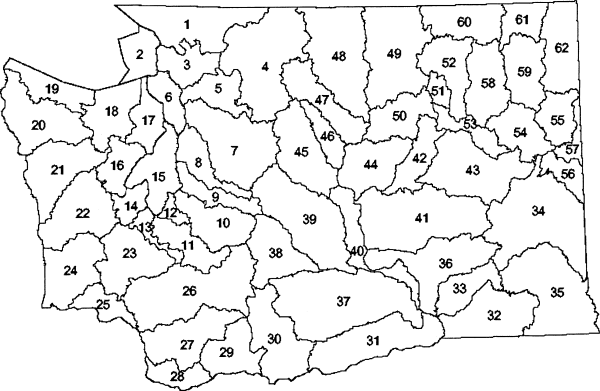 |
| Key: | |||
| 1. Nooksack | 21. Queets/Quinault | 41. Lower Crab | 61. Upper Lake Roosevelt |
| 2. San Juan | 22. Lower Chehalis | 42. Grand Coulee | 62. Pend Oreille |
| 3. Lower Skagit/Samish | 23. Upper Chehalis | 43. Upper Crab/Wilson | |
| 4. Upper Skagit | 24. Willapa | 44. Moses Coulee | |
| 5. Stillaguamish | 25. Grays/Elochoman | 45. Wenatchee | |
| 6. Island | 26. Cowlitz | 46. Entiat | |
| 7. Snohomish | 27. Lewis | 47. Chelan | |
| 8. Cedar/Sammamish | 28. Salmon/Washougal | 48. Methow | |
| 9. Duwamish/Green | 29. Wind/White Salmon | 49. Okanogan | |
| 10. Puyallup/White | 30. Klickitat | 50. Foster | |
| 11. Nisqually | 31. Rock/Glade | 51. Nespelem | |
| 12. Chambers/Clover | 32. Walla Walla | 52. Sanpoil | |
| 13. Deschutes | 33. Lower Snake | 53. Lower Lake Roosevelt | |
| 14. Kennedy/Goldsborough | 34. Palouse | 54. Lower Spokane | |
| 15. Kitsap | 35. Middle Snake | 55. Little Spokane | |
| 16. Skokomish/ Dosewallips |
36. Esquatzel Coulee | 56. Hangman | |
| 17. Quilcene/Snow | 37. Lower Yakima | 57. Middle Spokane | |
| 18. Elwha/Dungeness | 38. Naches | 58. Middle Lake Roosevelt | |
| 19. Lyre/Hoko | 39. Upper Yakima | 59. Colville | |
| 20. Soleduck/Hoh | 40. Alkaki/Squilchuck | 60. Kettle | |
| (( |
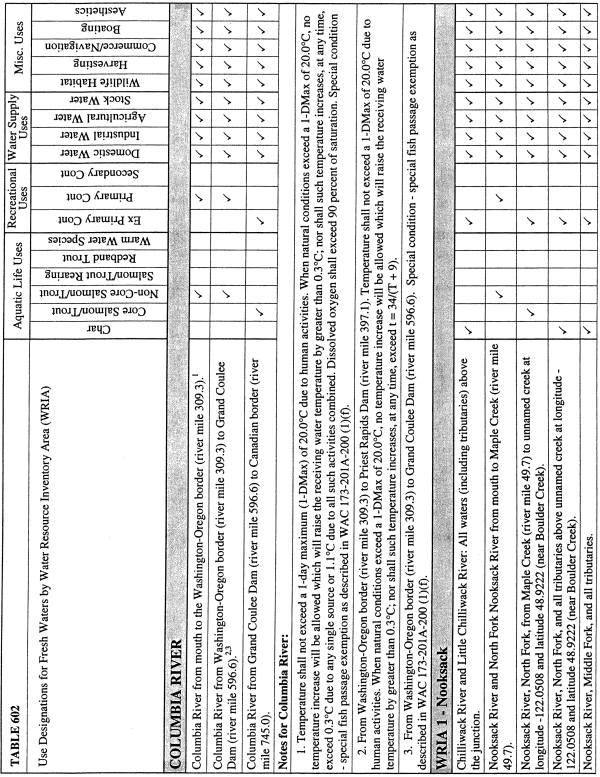 |
| (( |
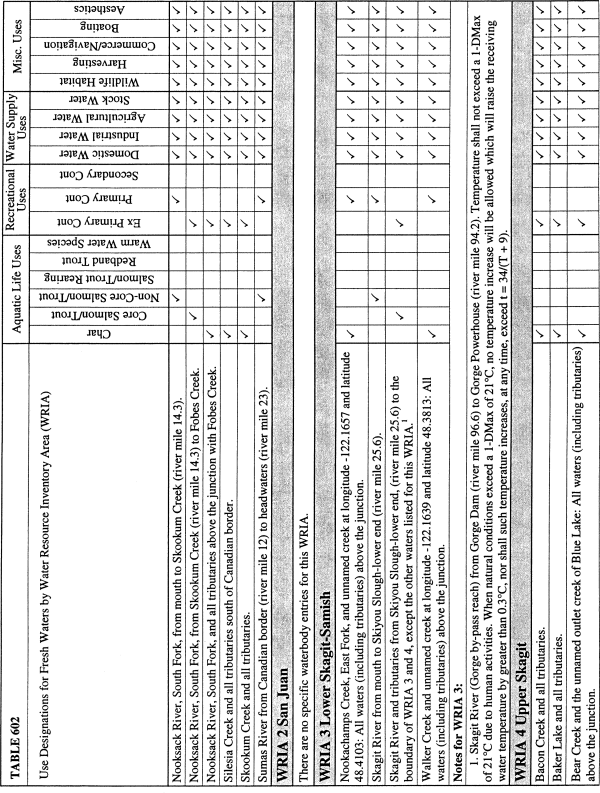 |
| (( |
 |
| (( |
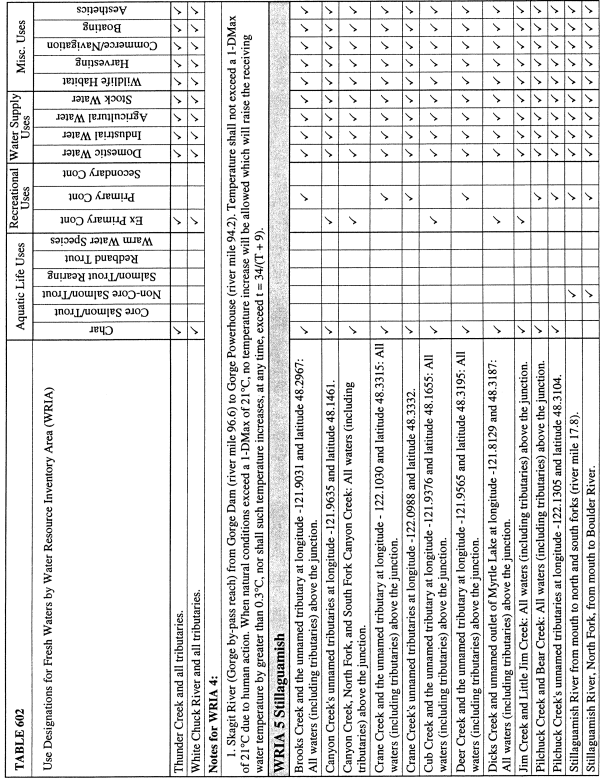 |
| (( |
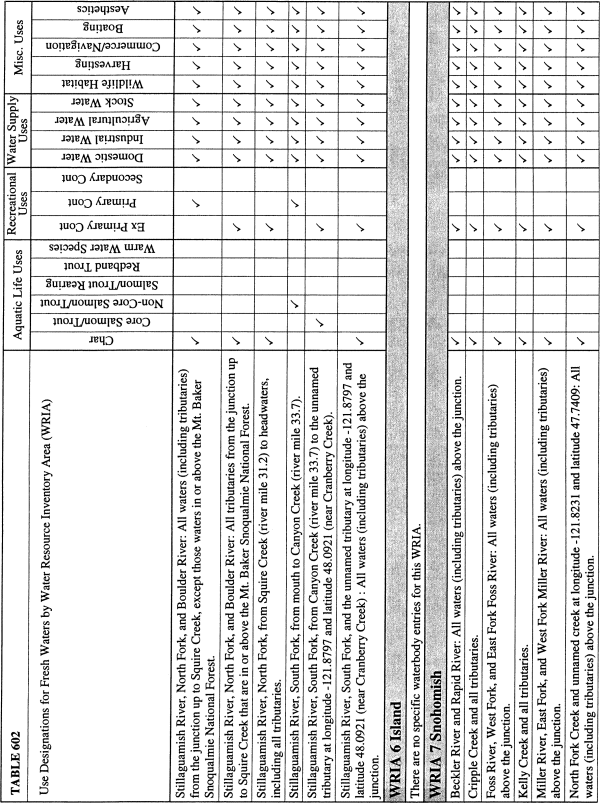 |
| (( |
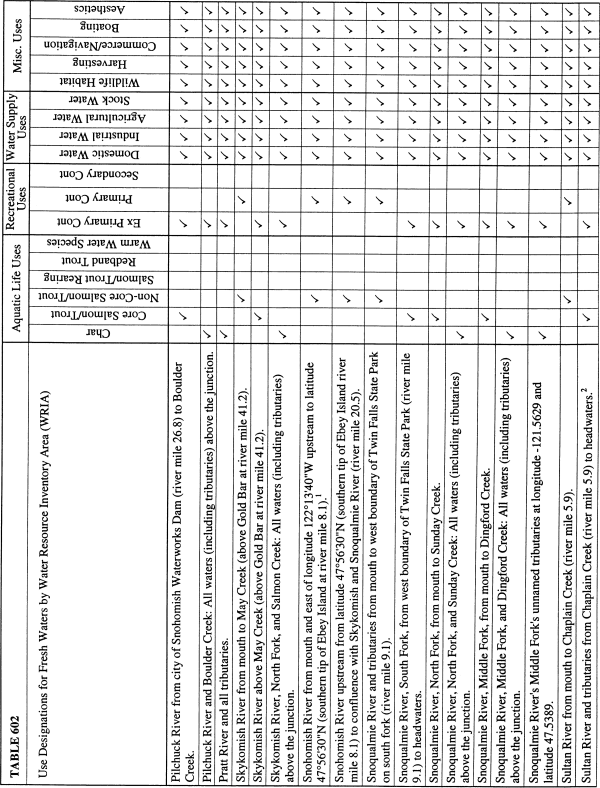 |
| (( |
 |
| (( |
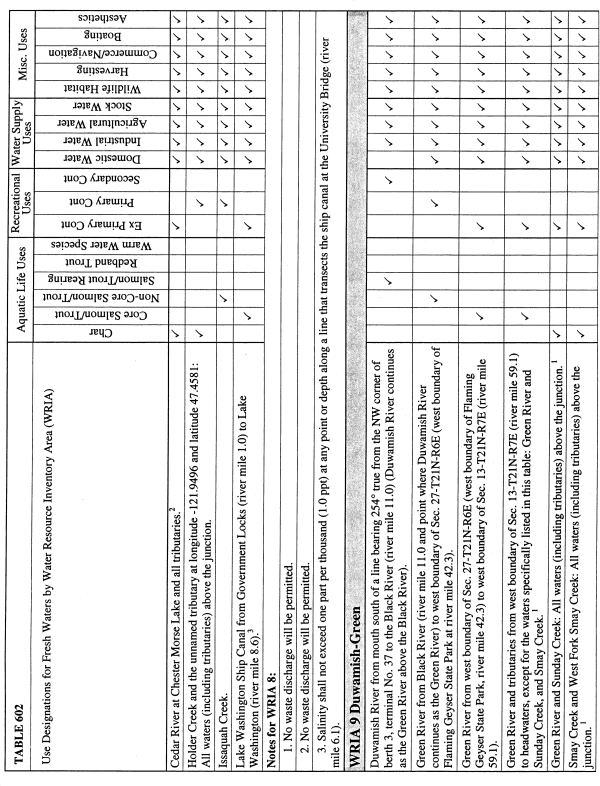 |
| (( |
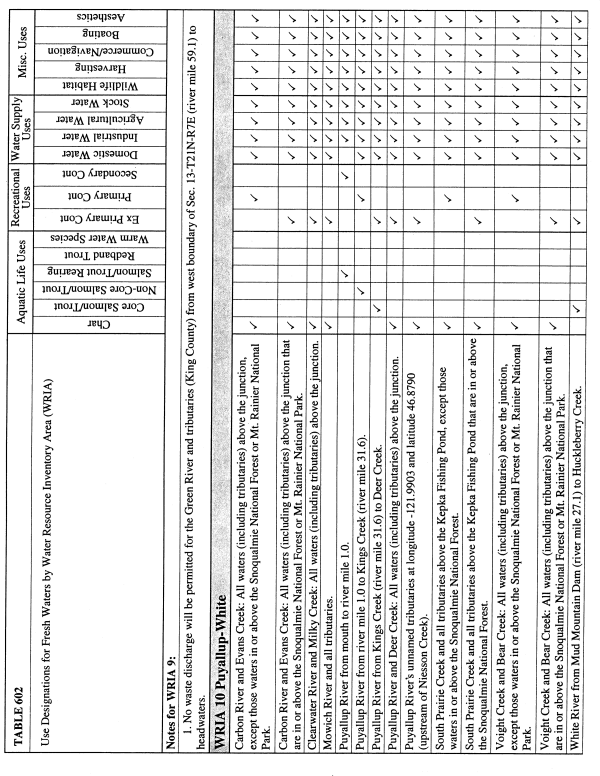 |
| (( |
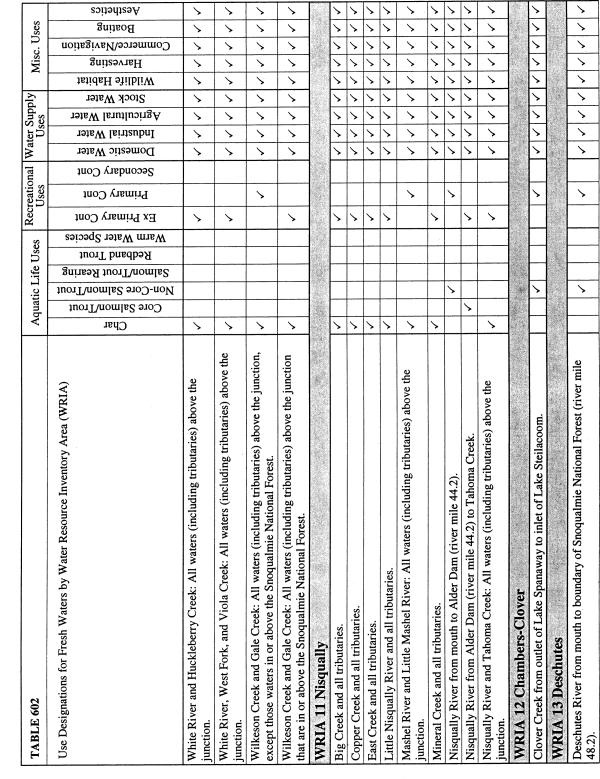 |
| (( |
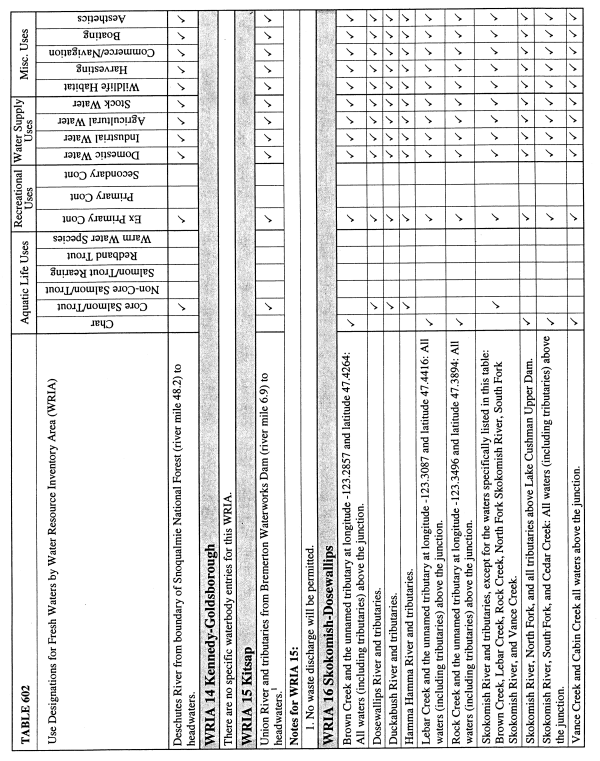 |
| (( |
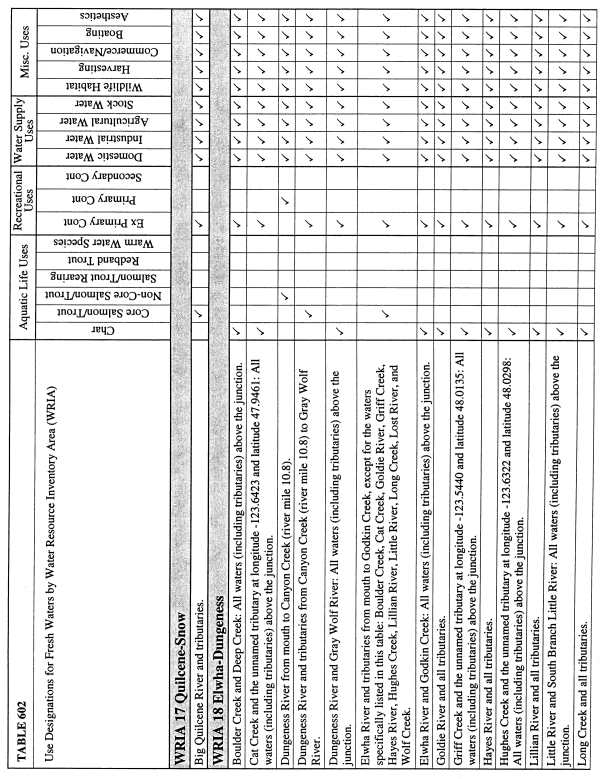 |
| (( |
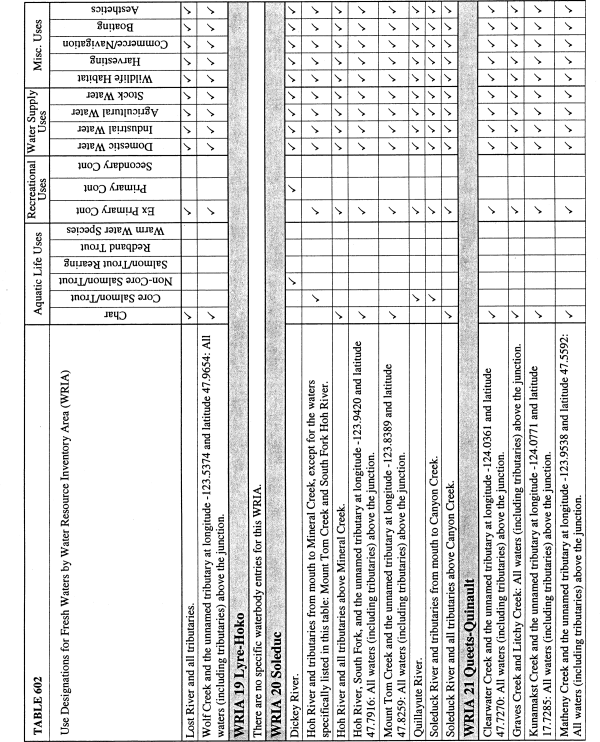 |
| (( |
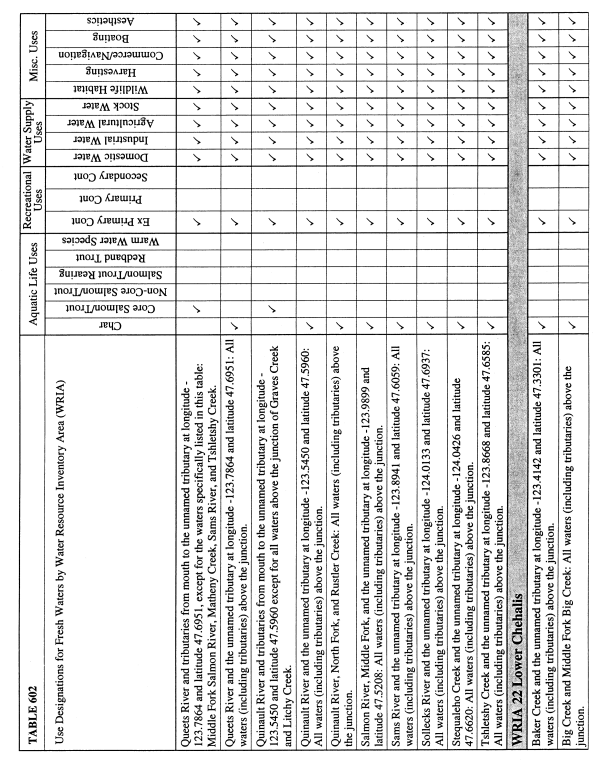 |
| (( |
 |
| (( |
 |
| (( |
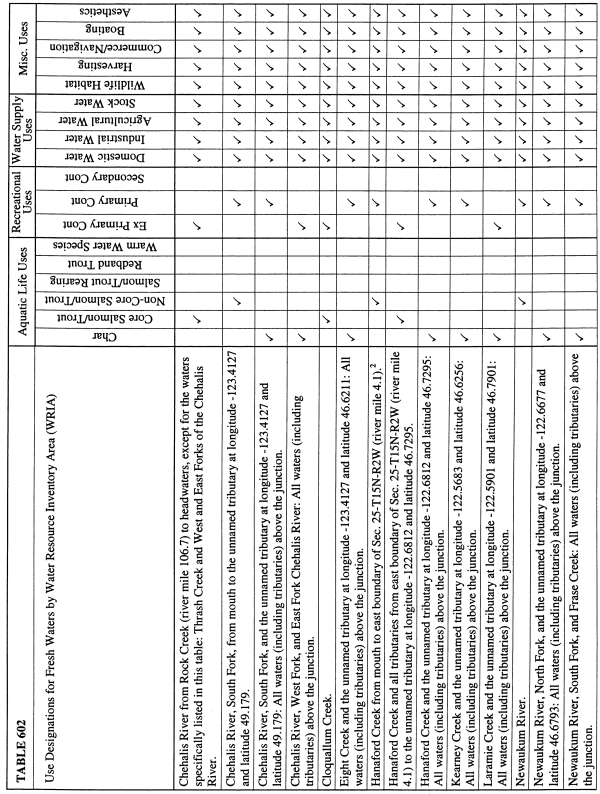 |
| (( |
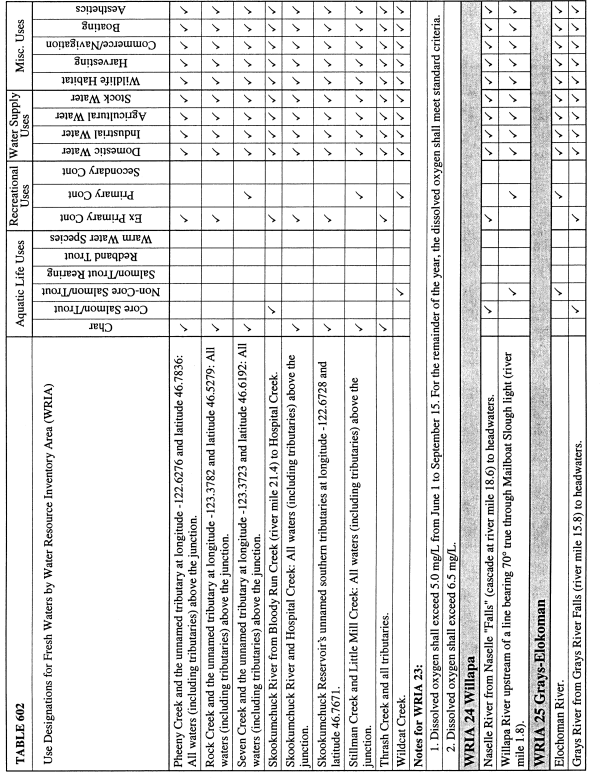 |
| (( |
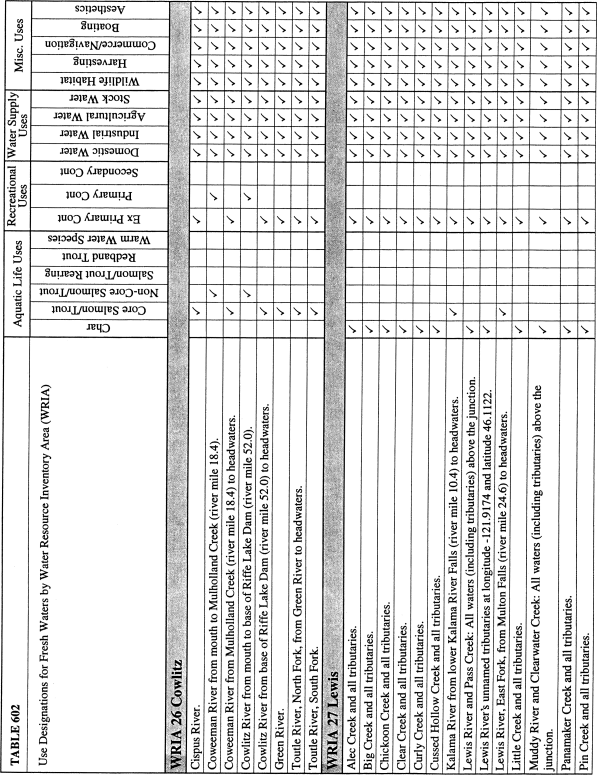 |
| (( |
 |
| (( |
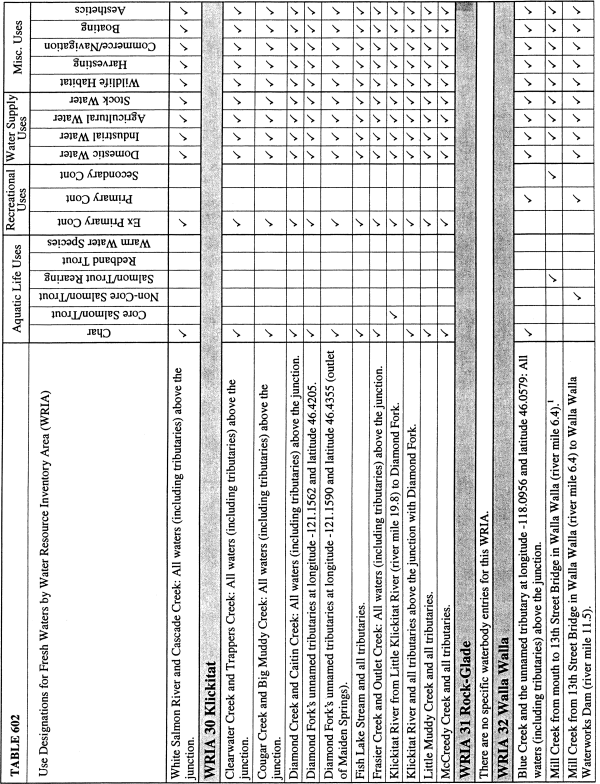 |
| (( |
 |
| (( |
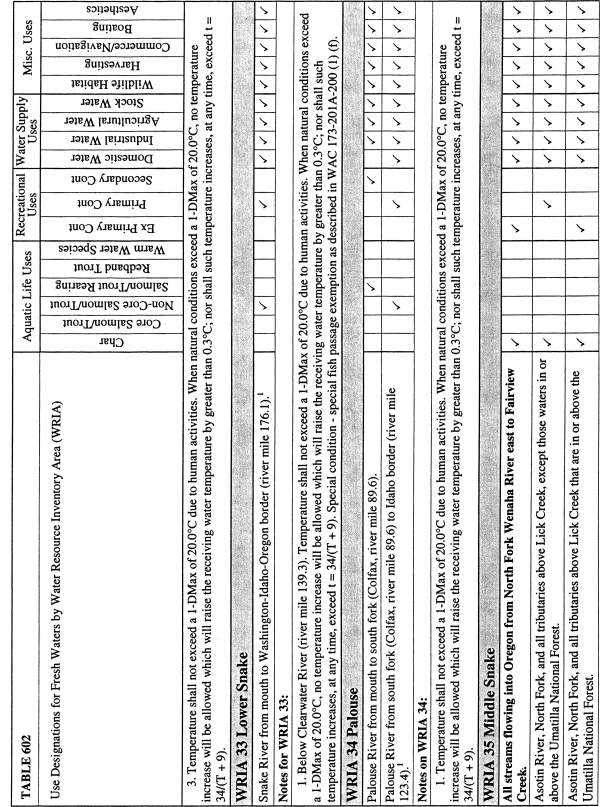 |
| (( |
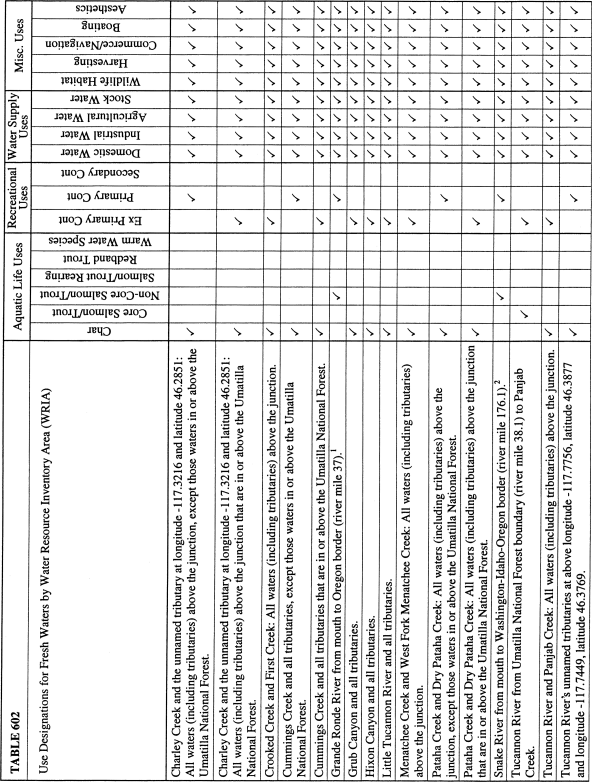 |
| (( |
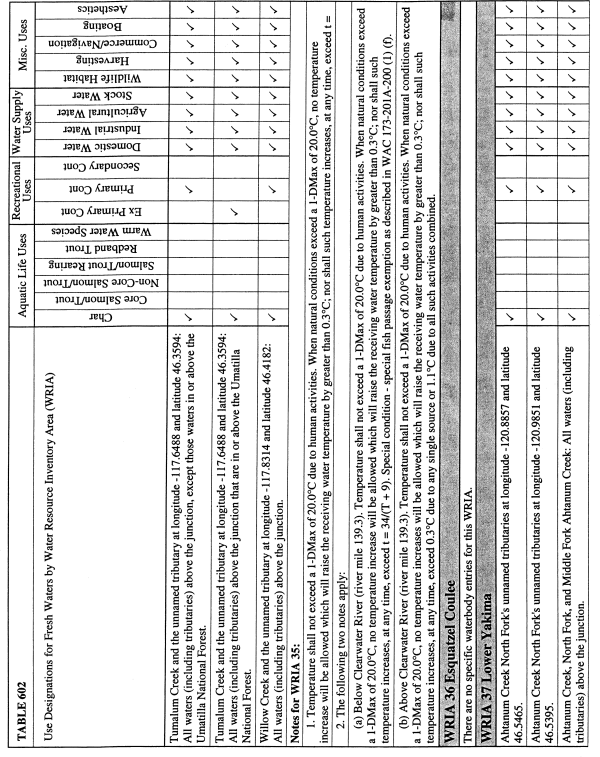 |
| (( |
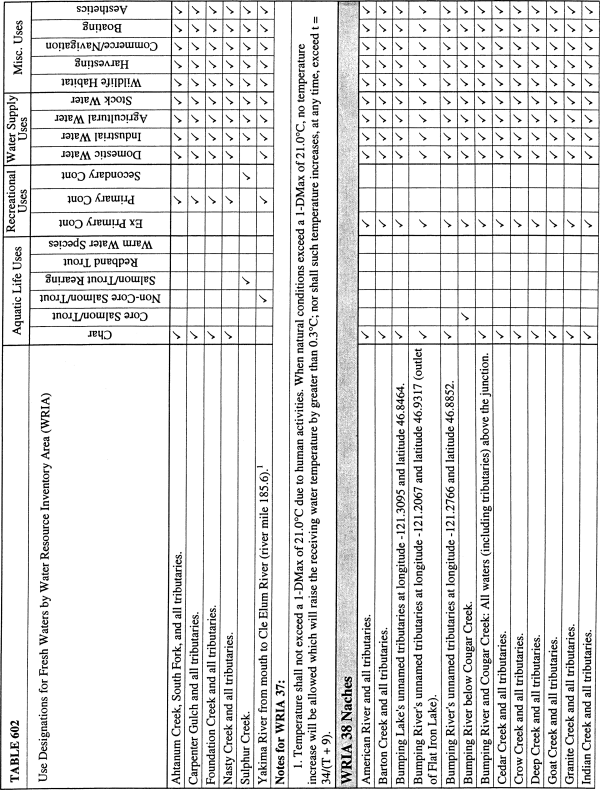 |
| (( |
 |
| (( |
 |
| (( |
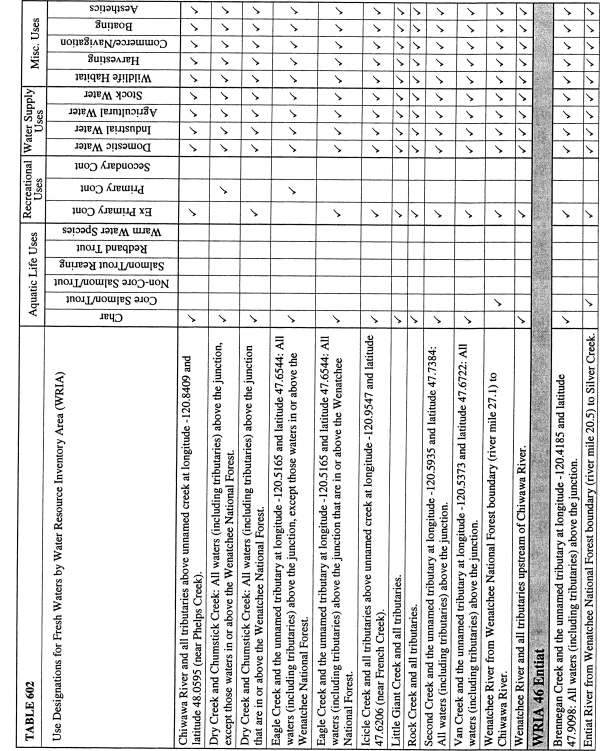 |
| (( |
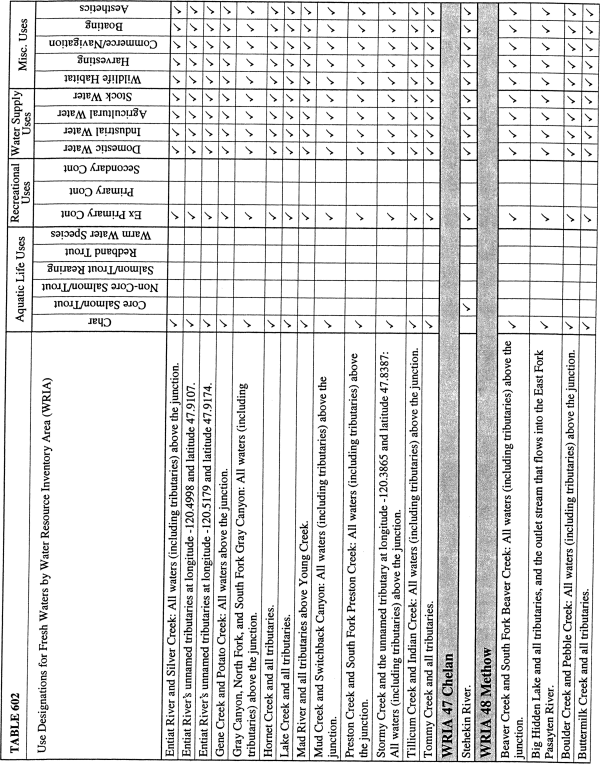 |
| (( |
 |
| (( |
 |
| (( |
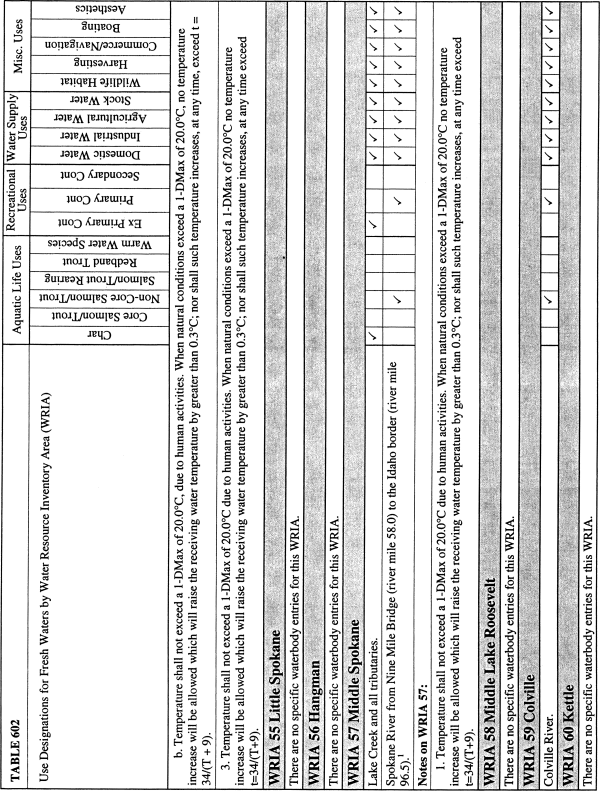 |
| (( |
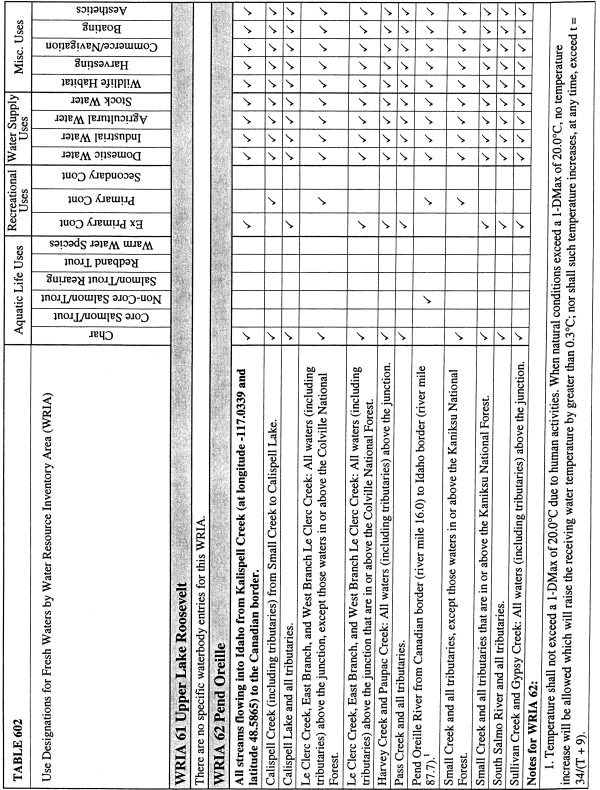 |

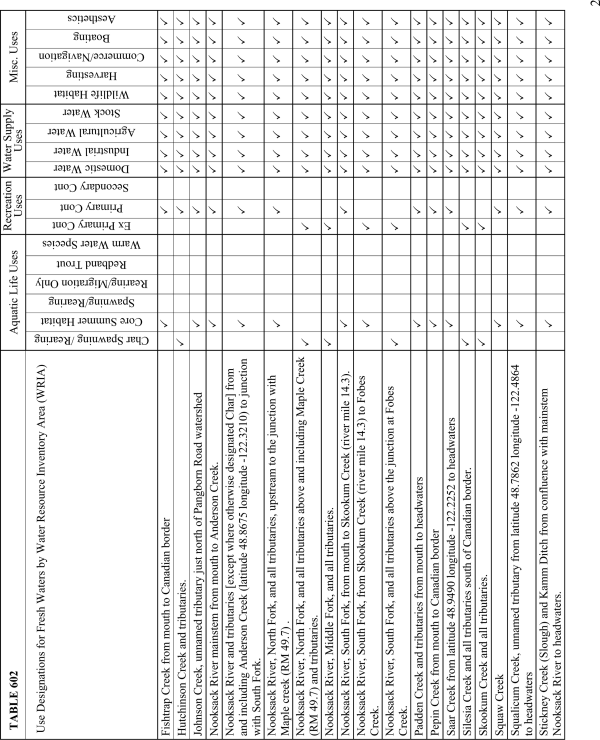
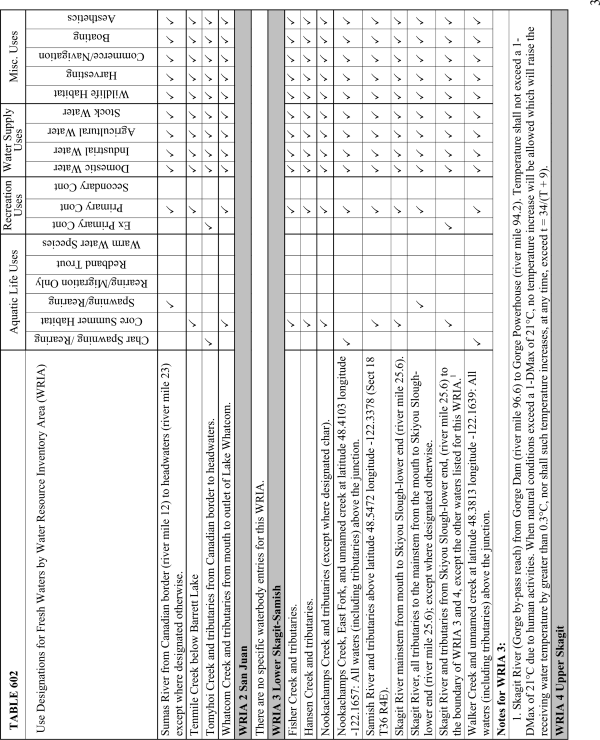
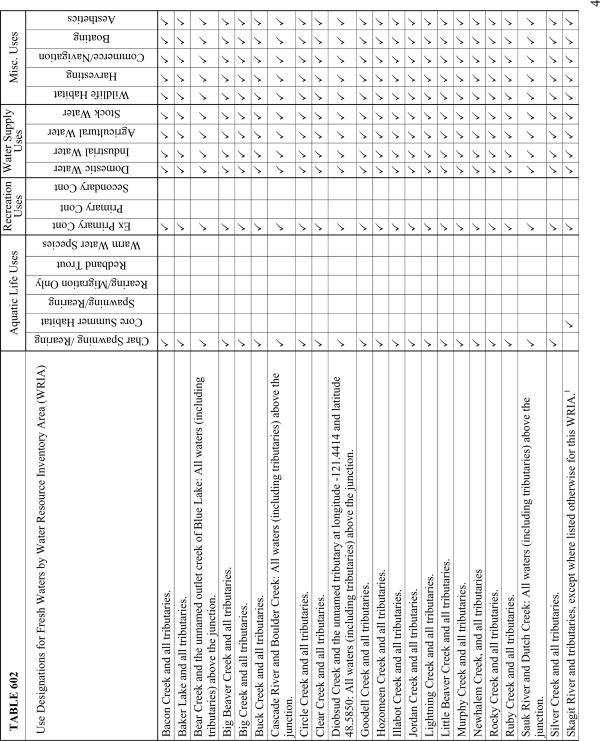
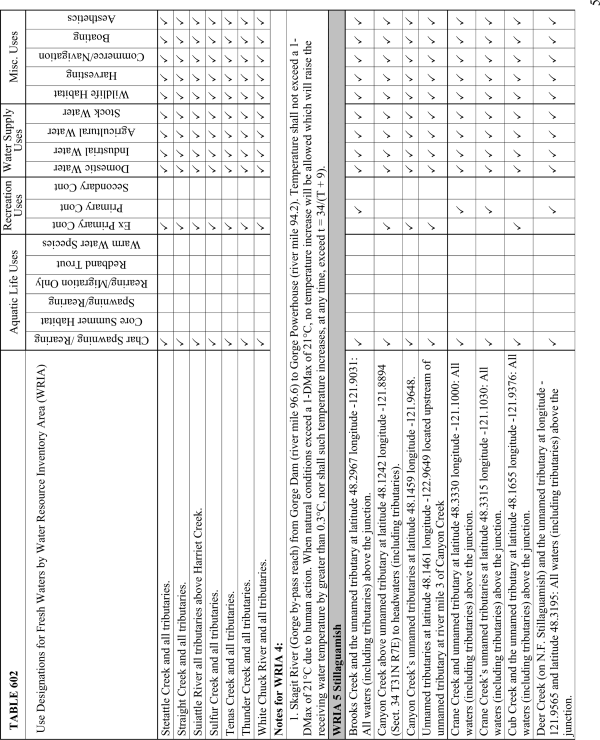

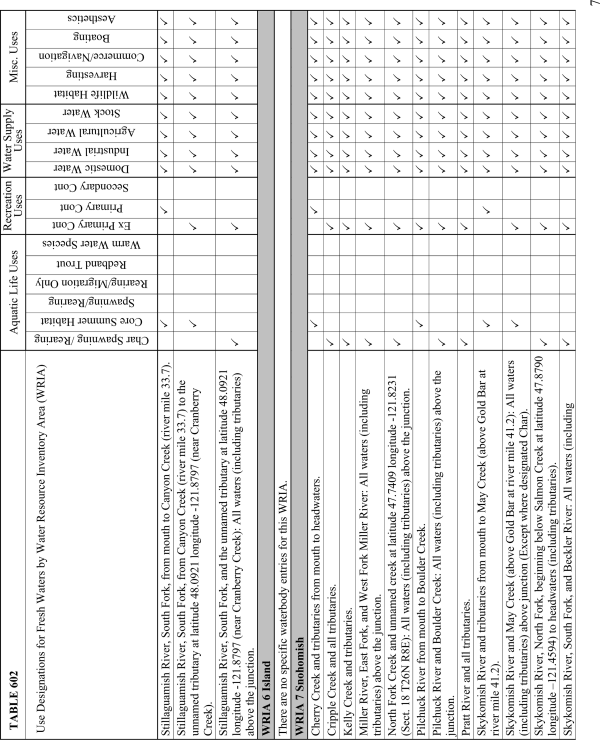
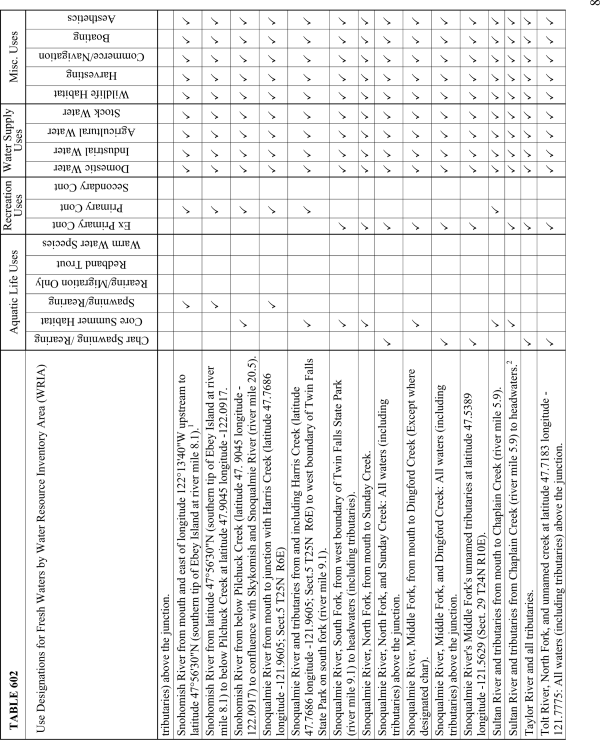
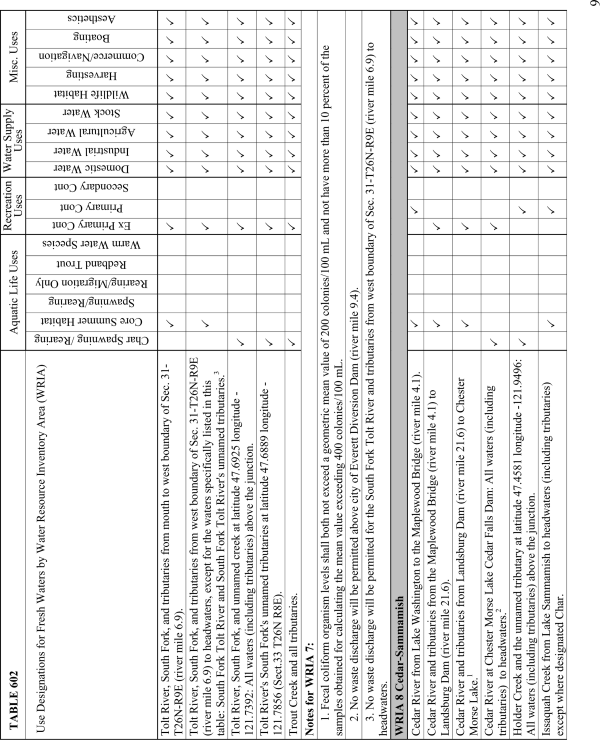
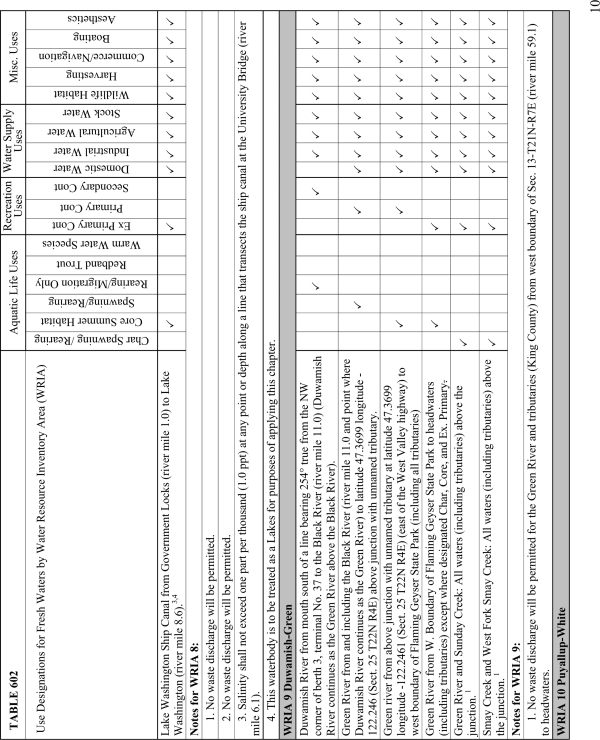
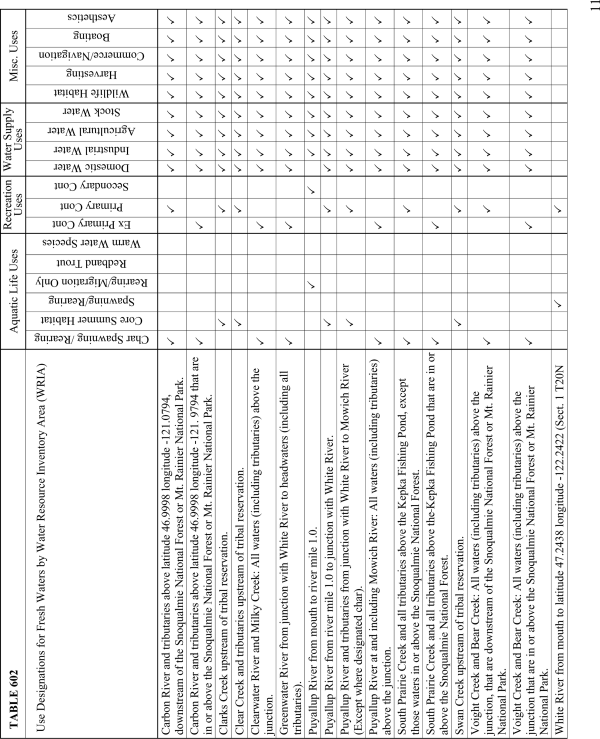
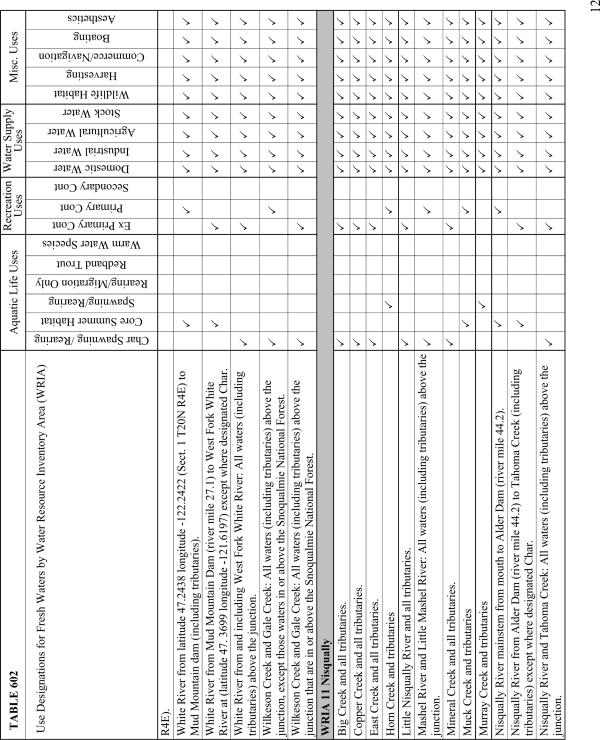
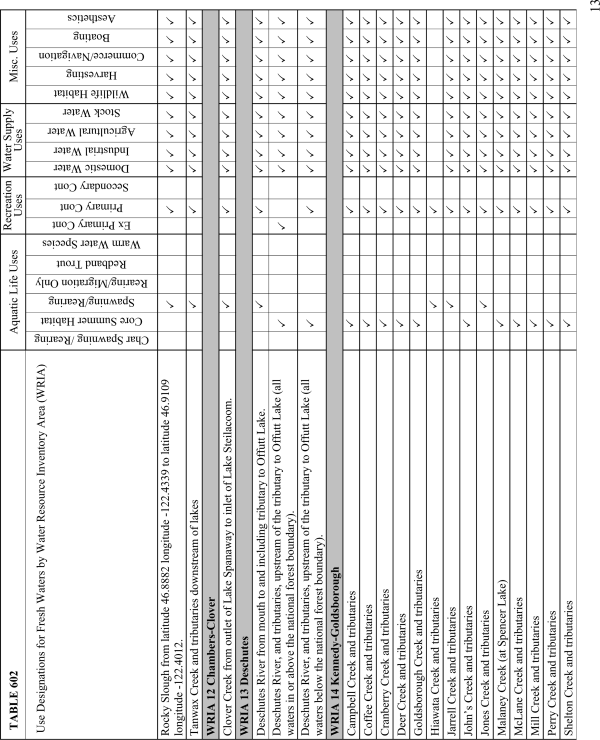
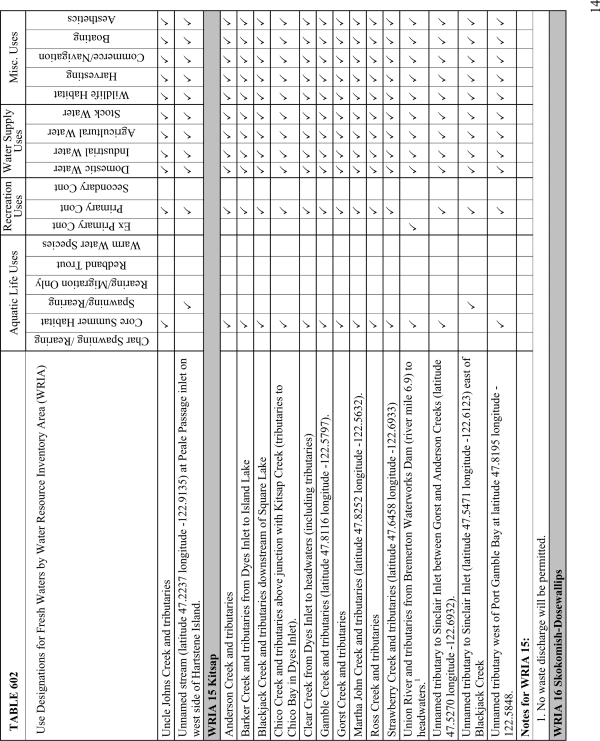
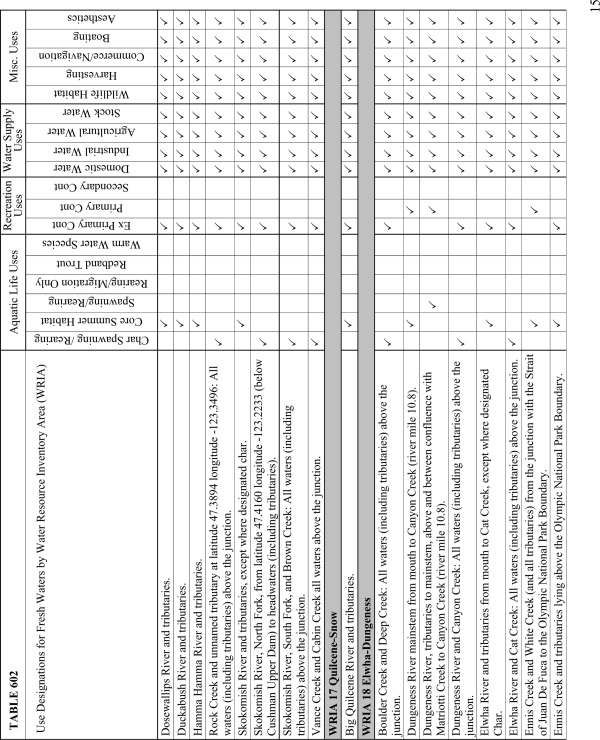
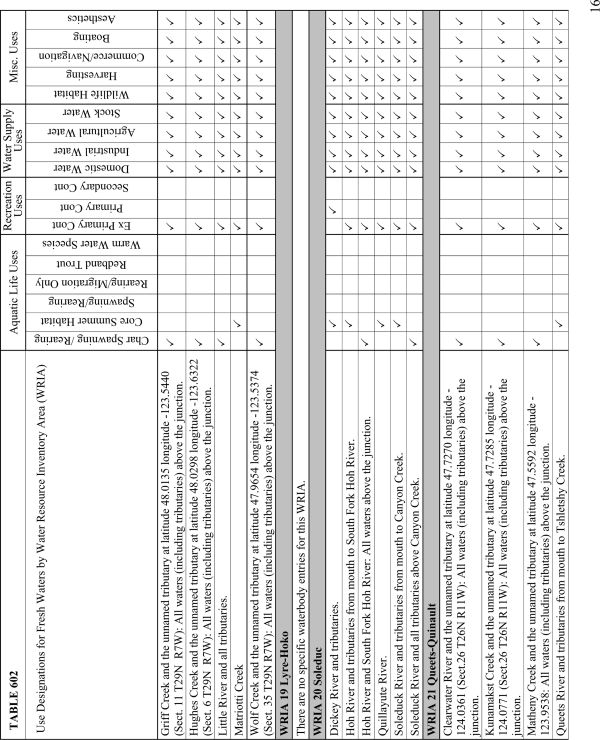
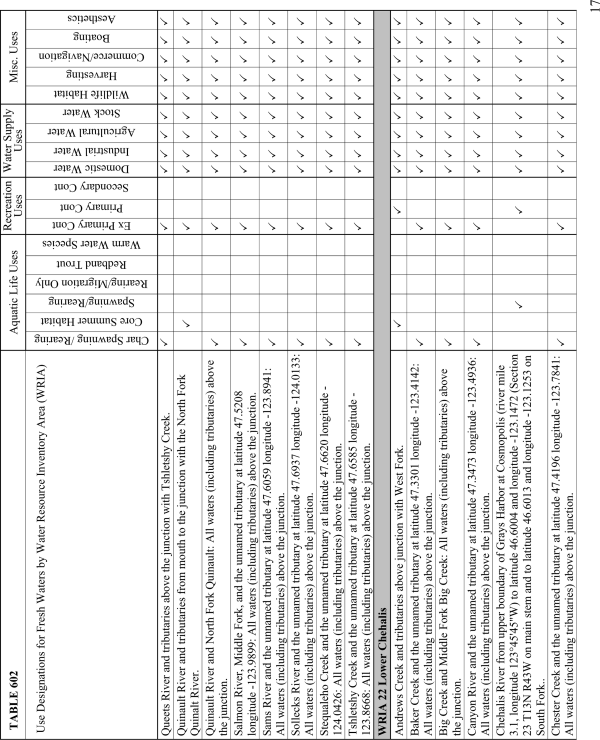
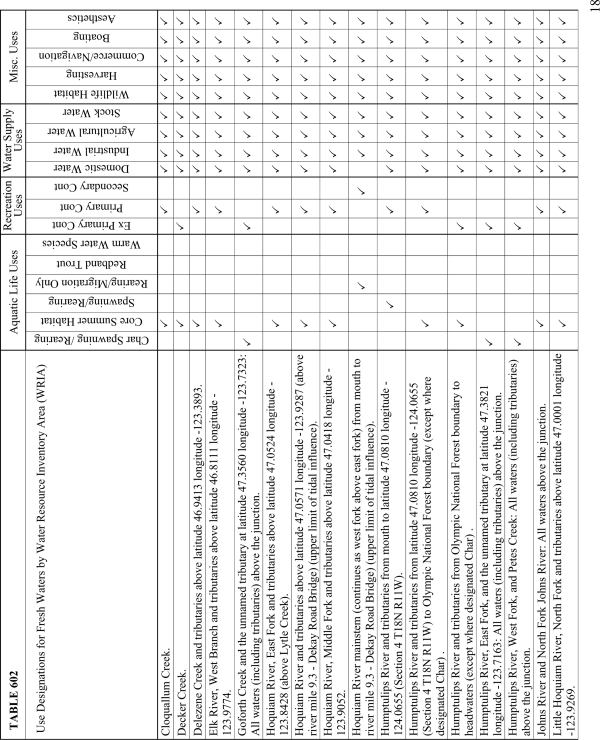

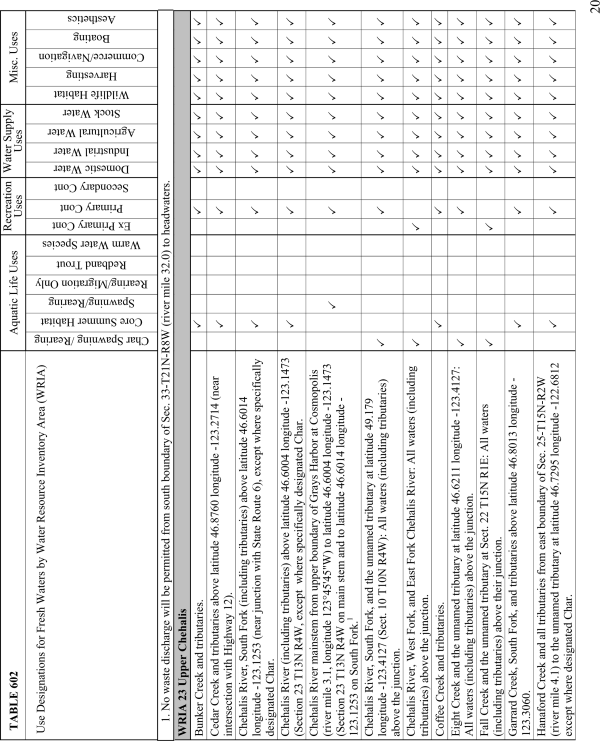

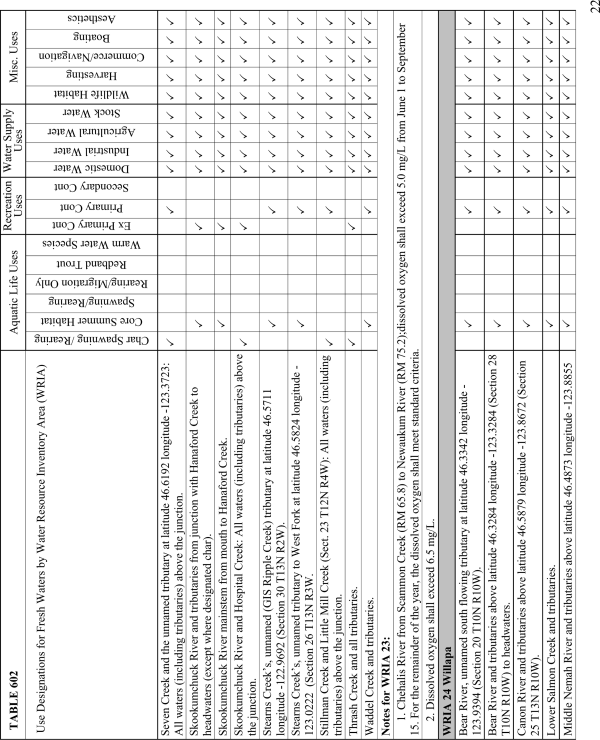
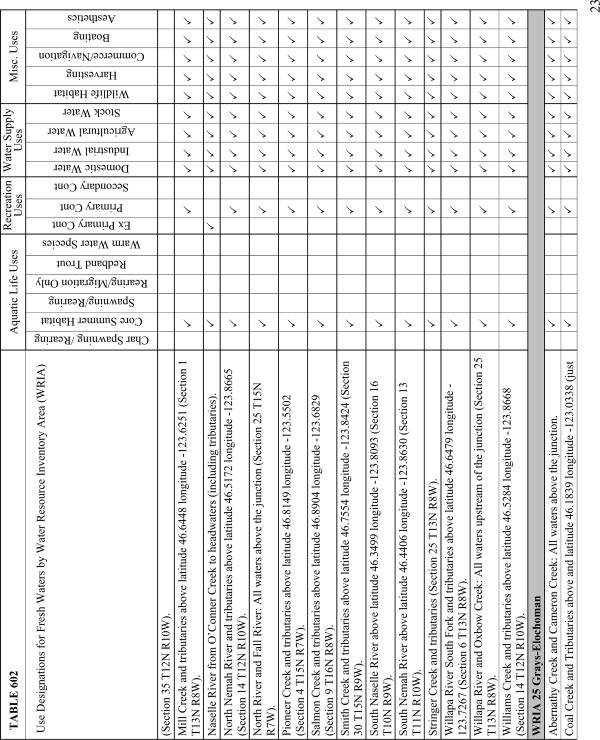
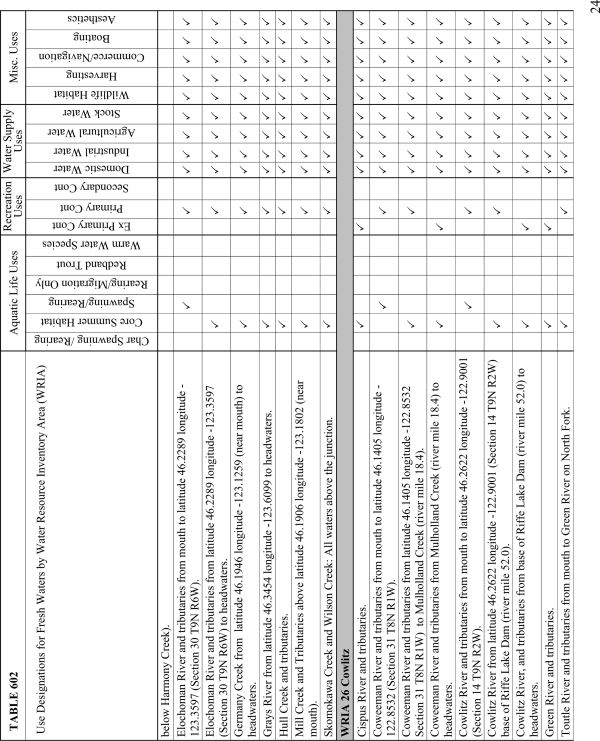
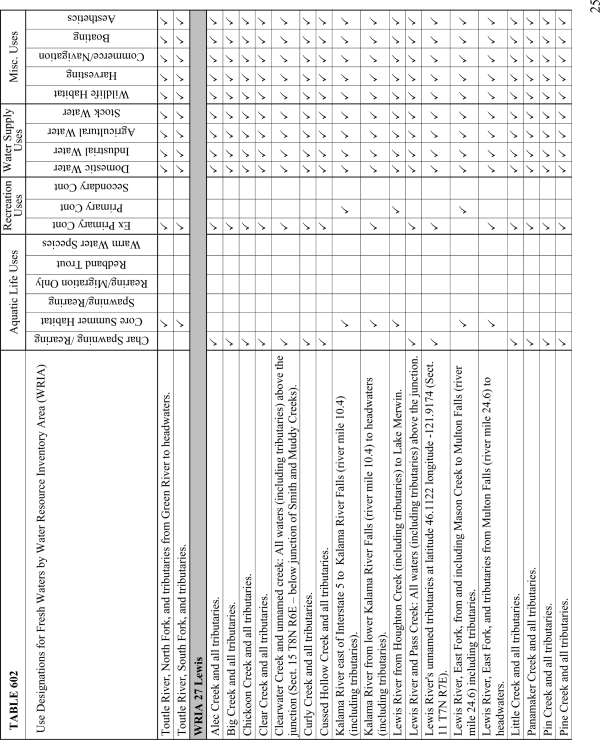
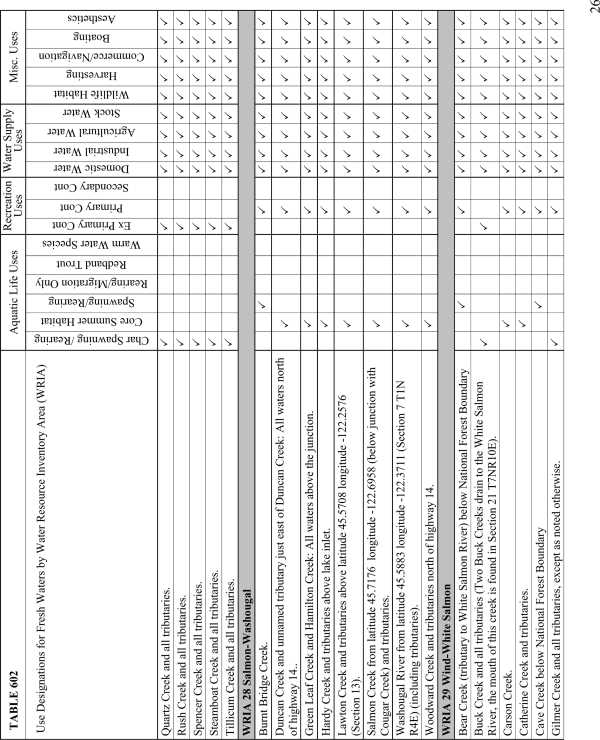
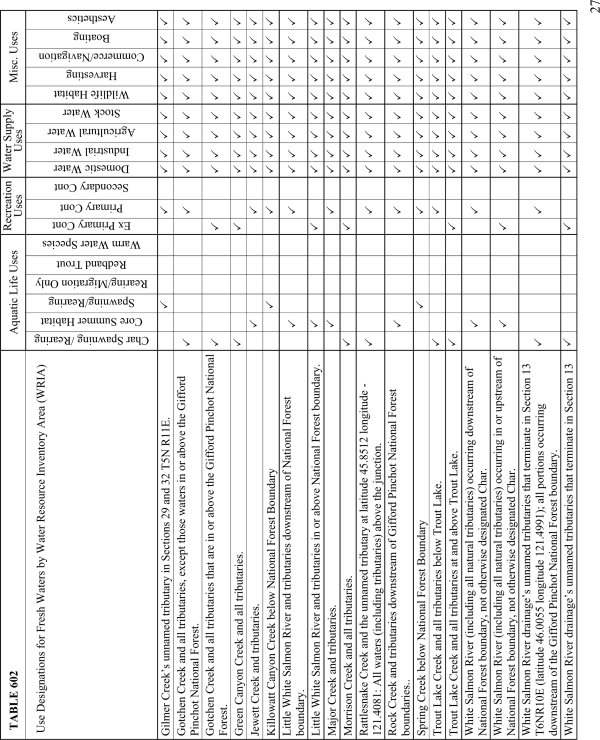
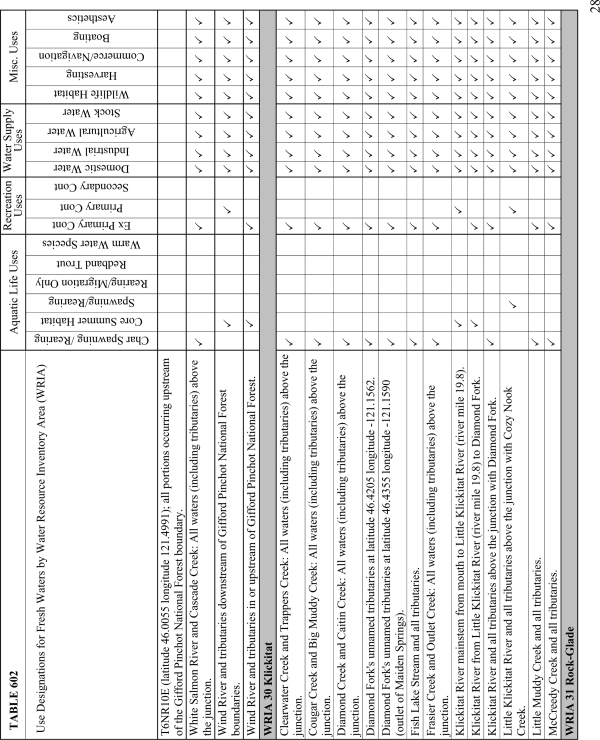
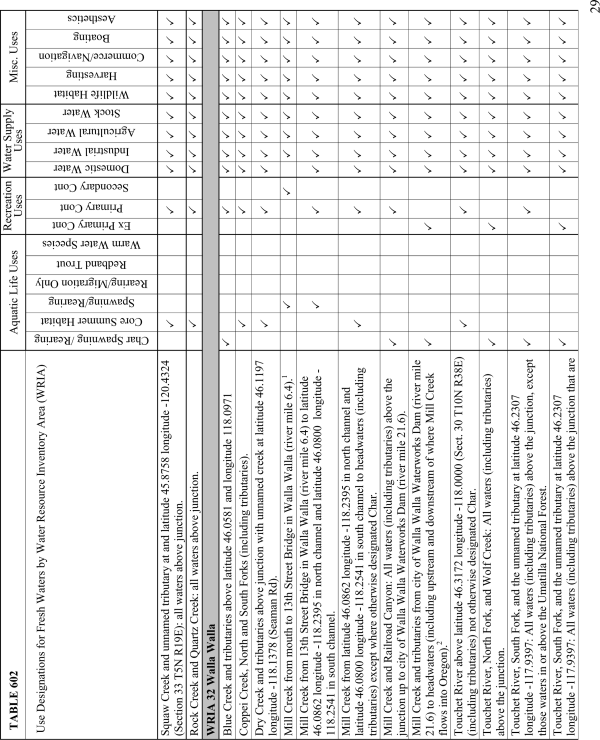
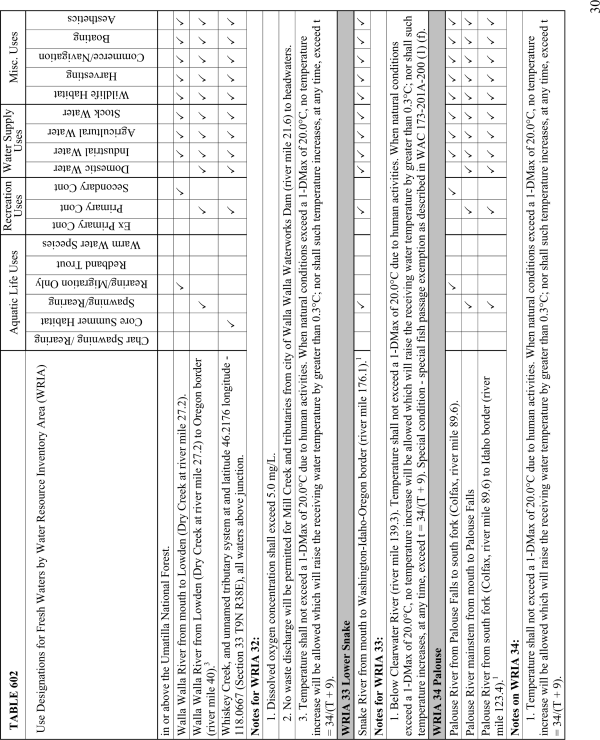

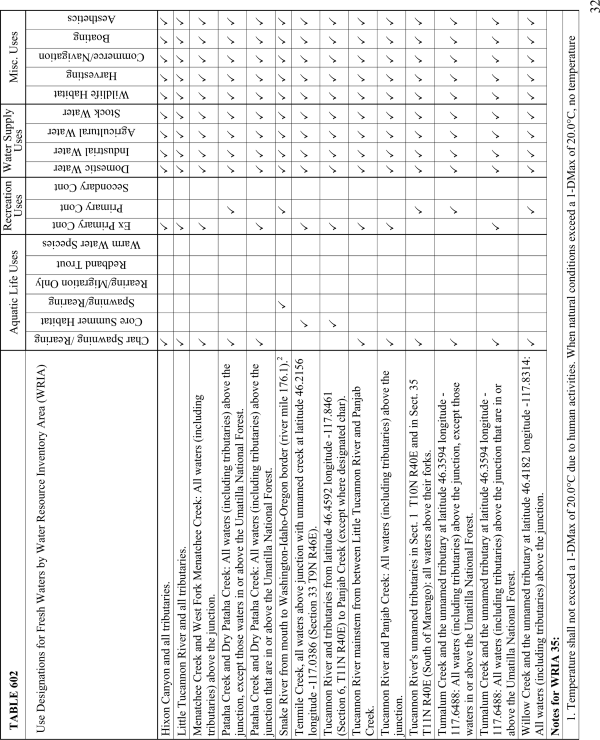
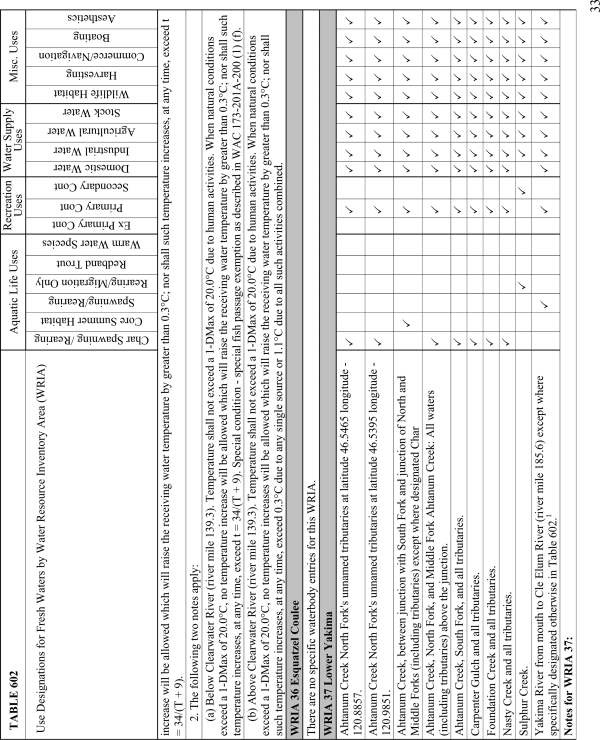
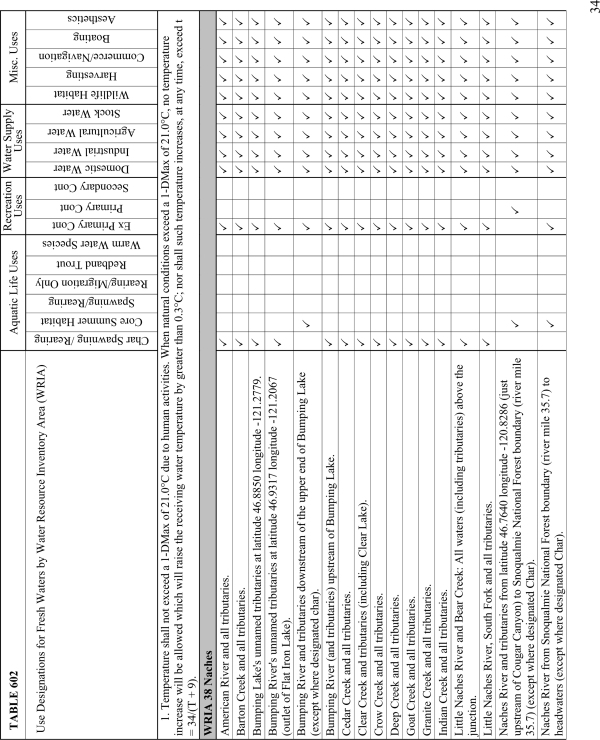
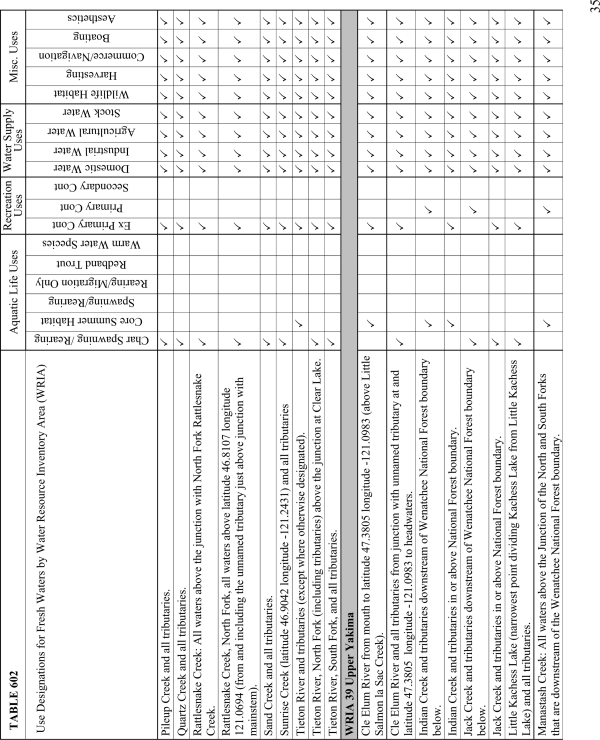
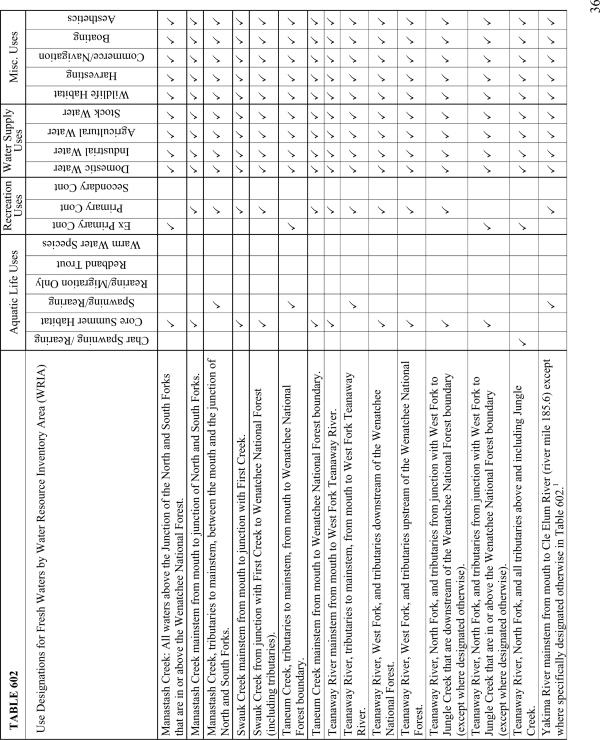

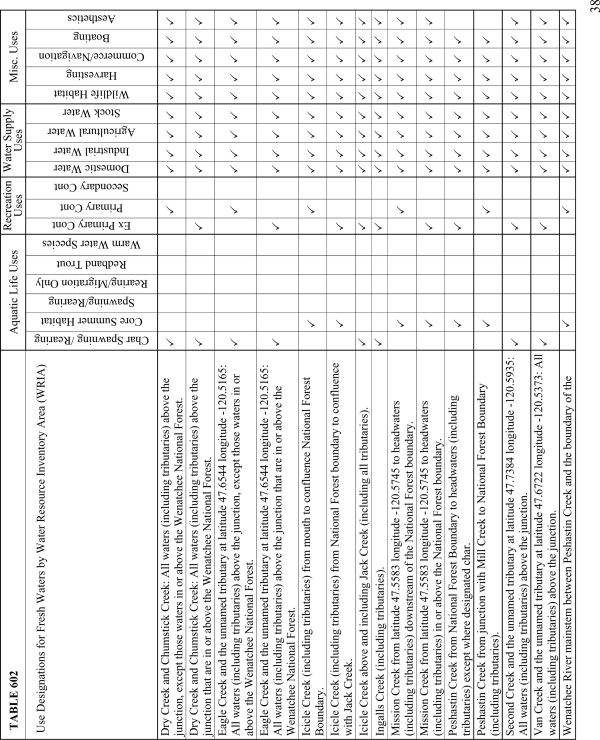

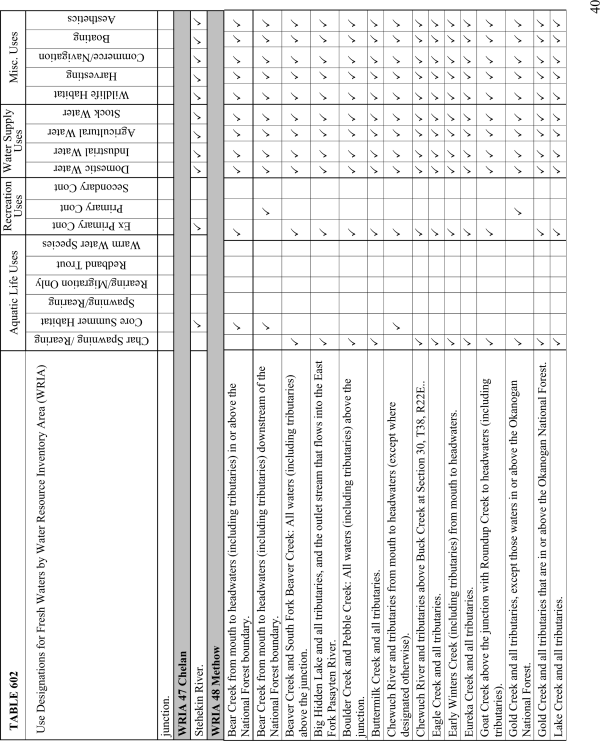
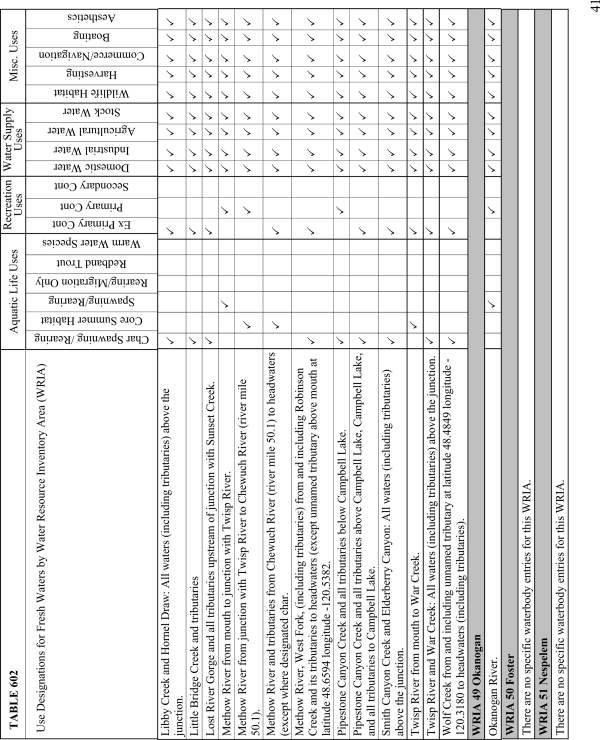
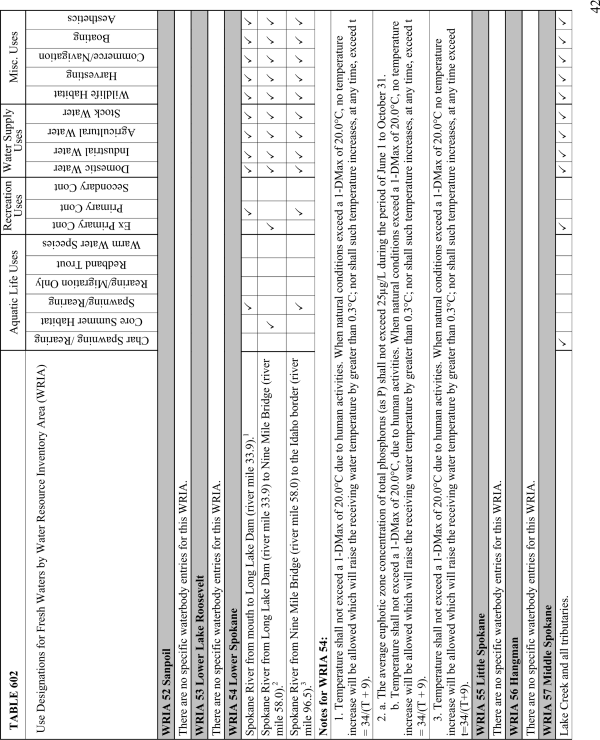
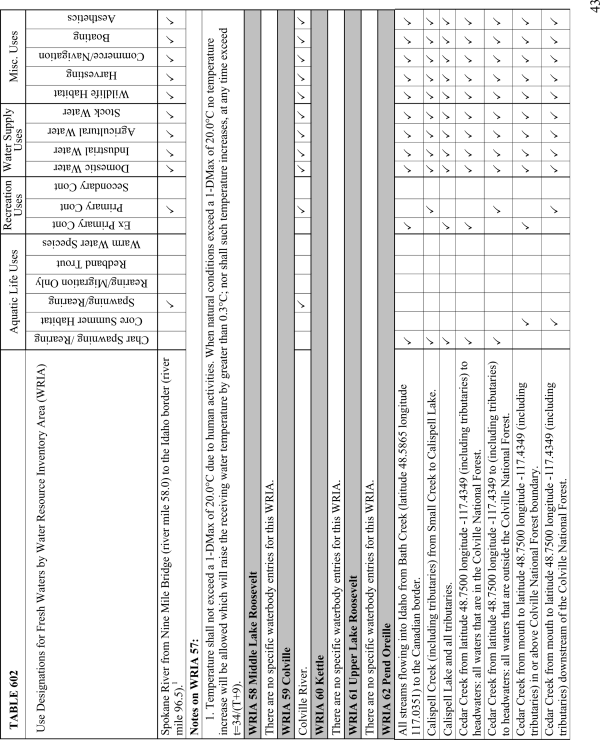

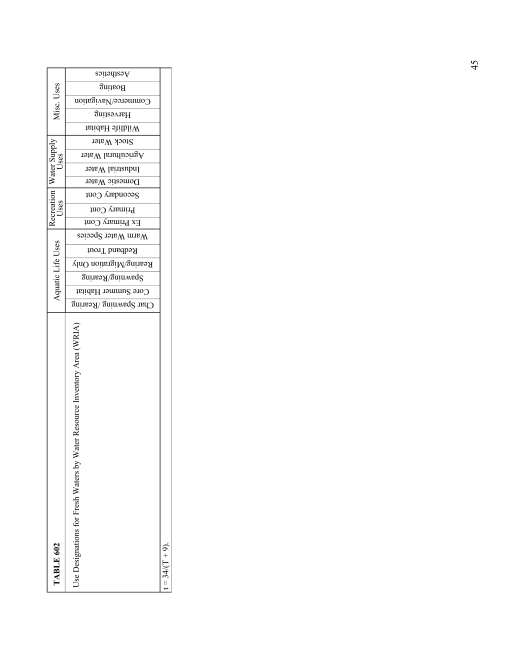
[Statutory Authority: Chapters 90.48 and 90.54 RCW. 03-14-129 (Order 02-14), § 173-201A-602, filed 7/1/03, effective 8/1/03.]
Reviser's note: The brackets and enclosed material in the text of the above section occurred in the copy filed by the agency and appear in the Register pursuant to the requirements of RCW 34.08.040.